Aperture's Blog, page 50
October 4, 2021
Announcing the 2021 PhotoBook Awards Shortlist
Initiated in 2012, the Paris Photo–Aperture Foundation PhotoBook Awards celebrate the photobook’s contributions to the evolving narrative of photography. Each year, thirty-five selected books are shortlisted in three major categories: First PhotoBook, PhotoBook of the Year, and Photography Catalogue of the Year.
This year’s shortlist selection took place over the course of three days at Aperture’s offices in New York, and involved the review of more than eight hundred submissions. The jury for the shortlist included Emilie Boone (art historian), Sonel Breslav (director of fairs and editions, Printed Matter), Darius Himes (international head of photographs, Christie’s), Lesley A. Martin (creative director, Aperture Foundation), and Jody Quon (director of photography, New York Magazine).
“This year’s submissions faced more than eighteen months of unprecedented production challenges in scheduling and labor, access to material, and the uncertainty of another important element in bookmaking—the ability of artists, publishers, and their collaborators to come together,” observed Breslav. “It’s inspiring to witness the resilience of these artists, subjects, and communities. We’ve all had to learn to adapt in order to continue our work, finding new directions along the way.”
The COVID-19 pandemic’s impact made itself known in more than one way, as Martin describes, through “the notable number of very strong, introspective projects that brought forth material grounded in the studio, as well as those drawn from archives and older bodies of work.” This year’s shortlist jury also selected three books as a Jurors’ Special Mention, acknowledging the prevalence of catalogues that responded to canceled shows or reduced audience access with publications that can also serve as DIY exhibitions.
A final jury will gather at Paris Photo this November to select the winners for all three categories. From there, the shortlisted and winning titles will be profiled in The PhotoBook Review (a newsprint publication that will accompany the Winter 2021 issue of Aperture magazine) and exhibited in Paris, New York, and tour internationally thereafter.
Below, see the thirty-five selected titles for the 2021 PhotoBook Awards shortlist.
First PhotoBook

Andrea Alessandrini, Piccola Russia, Witty Books, Turin, Italy

Indu Antony, Why can’t bras have buttons?, Mazhi Books (self-published), Bangalore, India

Archivo de la Memoria Trans Argentina and Verónica Fieiras, eds., Archivo de la Memoria Trans Argentina, CHACO, Buenos Aires

Melba Arellano, Carretera Nacional, Los Sumergidos, Hudson, New York

Wiosna van Bon, Family Stranger, Eriskay Connection, Breda, Netherlands

Deanna Dikeman, Leaving and Waving, Chose Commune, Marseille, France
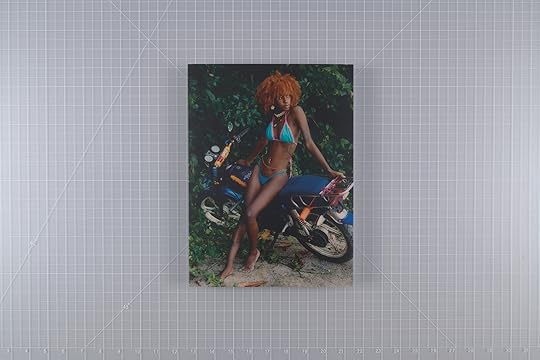
Jeano Edwards, EverWonderful, Self-published, Brooklyn

Nancy Floyd, Weathering Time, GOST Books, London
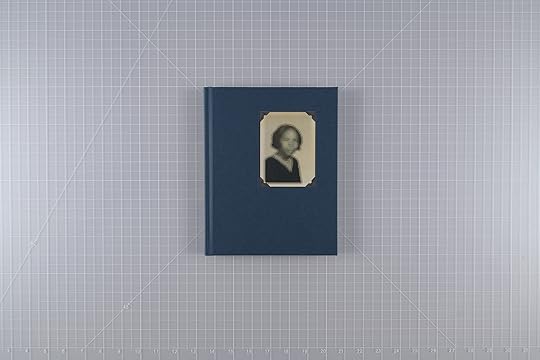
Will Harris, You Can Call Me Nana, Overlapse, London
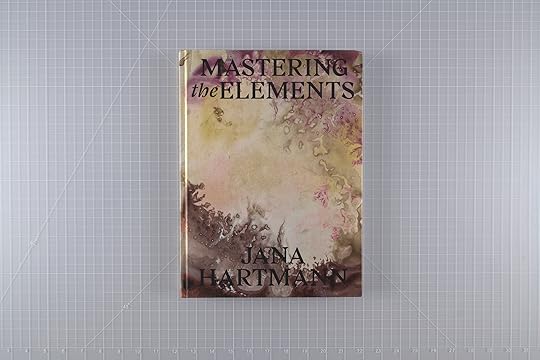
Jana Hartmann, Mastering the Elements, Eriskay Connection, Breda, Netherlands

Joe Johnson, Office Hours, There There Now, Columbia, Missouri

Tarrah Krajnak, El jardín de senderos que se bifurcan, Dais Books, Casper, Wyoming
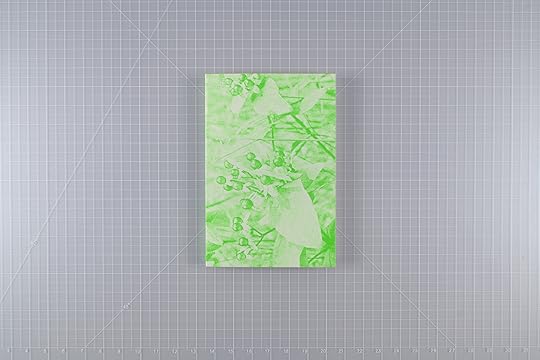
Luke Le, What are you looking for?, Perimeter Editions, Melbourne, Australia

Kanta Nomura, The Yoshida Dormitory Students’ History, Reminders Photography Stronghold, Tokyo
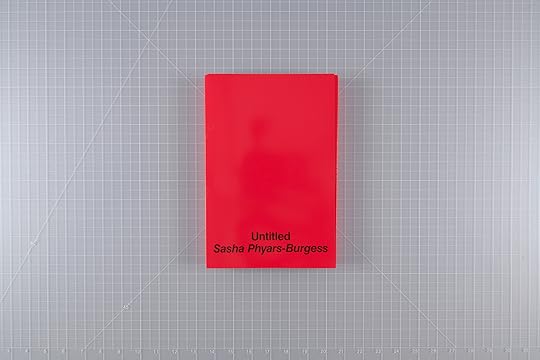
Sasha Phyars-Burgess, Untitled, Capricious Publishing, New York
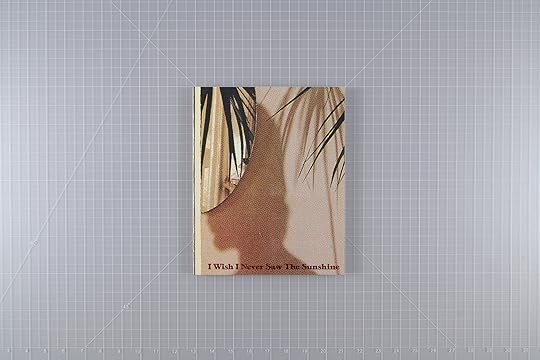
Pacifico Silano, I Wish I Never Saw the Sunshine, Loose Joints, Marseille, France
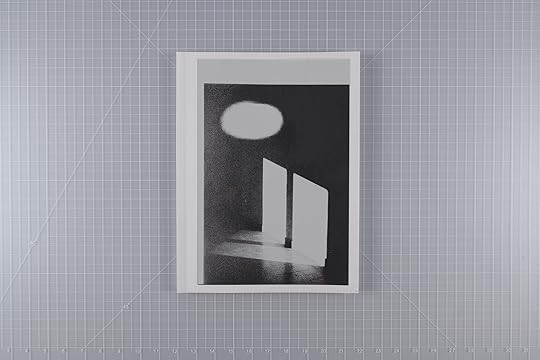
Sebastian Stadler, A Close Up of a Large Rock, I Think, Kodoji Press, Baden, Switzerland

Al J Thompson, Remnants of an Exodus, Gnomic Book, Portland, Oregon

Eva Veldhoen, Play, Self-published, Utrecht, Netherlands

Elliott Verdier, Reaching for Dawn, Dunes, Paris
Previous NextAndrea Alessandrini
Piccola Russia
Witty Books, Turin, Italy
Indu Antony
Why can’t bras have buttons?
Mazhi Books (self-published), Bangalore, India
Archivo de la Memoria Trans Argentina and Verónica Fieiras, eds.
Archivo de la Memoria Trans Argentina
CHACO, Buenos Aires
Melba Arellano
Carretera Nacional
Los Sumergidos, Hudson, New York
Wiosna van Bon
Family Stranger
Eriskay Connection, Breda, Netherlands
Deanna Dikeman
Leaving and Waving
Chose Commune, Marseille, France
Jeano Edwards
EverWonderful
Self-published, Brooklyn
Nancy Floyd
Weathering Time
GOST Books, London
Will Harris
You Can Call Me Nana
Overlapse, London
Jana Hartmann
Mastering the Elements
Eriskay Connection, Breda, Netherlands
Joe Johnson
Office Hours
There There Now, Columbia, Missouri
Tarrah Krajnak
El jardín de senderos que se bifurcan
Dais Books, Casper, Wyoming
Luke Le
What are you looking for?
Perimeter Editions, Melbourne, Australia
Kanta Nomura
The Yoshida Dormitory Students’ History
Reminders Photography Stronghold, Tokyo
Sasha Phyars-Burgess
Untitled
Capricious Publishing, New York
Pacifico Silano
I Wish I Never Saw the Sunshine
Loose Joints, Marseille, France
Sebastian Stadler
A Close Up of a Large Rock, I Think
Kodoji Press, Baden, Switzerland
Al J Thompson
Remnants of an Exodus
Gnomic Book, Portland, Oregon
Eva Veldhoen
Play
Self-published, Utrecht, Netherlands
Elliott Verdier
Reaching for Dawn
Dunes, Paris
PhotoBook of the Year

Farah Al Qasimi, Hello Future, Capricious Publishing, New York

Jessica Backhaus, Cut Outs, Kehrer Verlag, Heidelberg, Germany
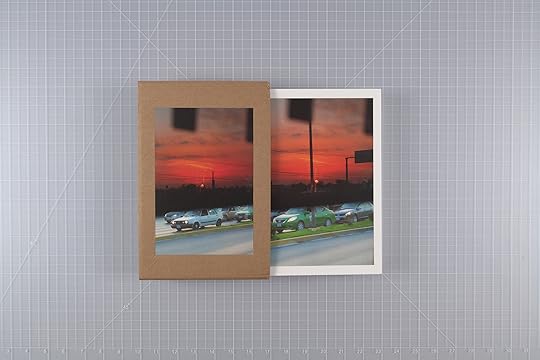
Alejandro Cartagena, Suburban Bus, The Velvet Cell, Berlin

Bieke Depoorter, Agata, Des Palais (self-published), Ghent, Belgium

Isaac Diggs and Edward Hillel, Electronic Landscapes: Music, Space and Resistance in Detroit, +KGP, Queens, New York
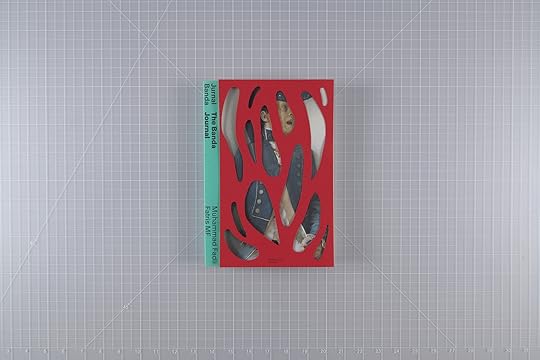
Muhammad Fadli and Fatris MF, The Banda Journal, Jordan, jordan Édition, Jakarta, Indonesia
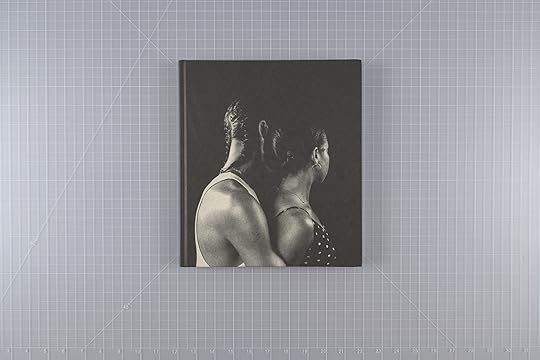
Rahim Fortune, I Can’t Stand to See You Cry, Loose Joints, Marseille, France
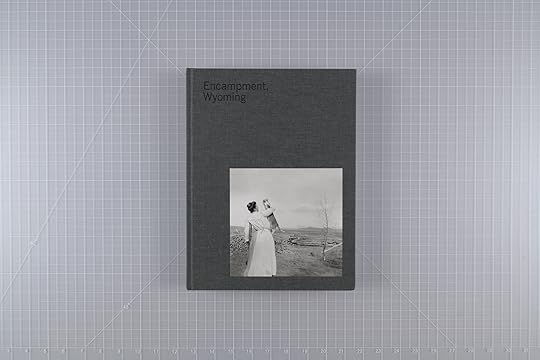
Lora Webb Nichols, Encampment, Wyoming, Fw:Books, Amsterdam
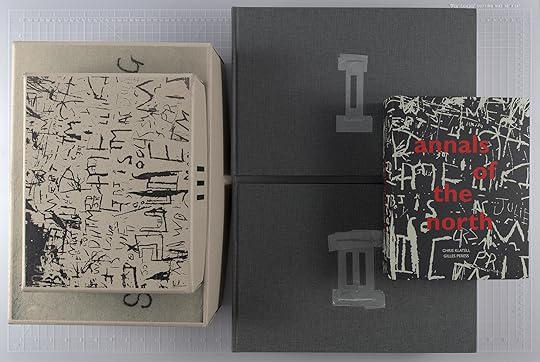
Gilles Peress, Whatever You Say, Say Nothing, Steidl, Göttingen, Germany

Vasantha Yogananthan, Amma, Chose Commune, Marseille, France
Previous NextFarah Al Qasimi
Hello Future
Capricious Publishing, New York
Jessica Backhaus
Cut Outs
Kehrer Verlag, Heidelberg, Germany
Alejandro Cartagena
Suburban Bus
The Velvet Cell, Berlin
Bieke Depoorter
Agata
Des Palais (self-published), Ghent, Belgium
Isaac Diggs and Edward Hillel
Electronic Landscapes: Music, Space and Resistance in Detroit
+KGP, Queens, New York
Muhammad Fadli and Fatris MF
The Banda Journal
Jordan, jordan Édition, Jakarta, Indonesia
Rahim Fortune
I Can’t Stand to See You Cry
Loose Joints, Marseille, France
Lora Webb Nichols
Encampment, Wyoming
Fw:Books, Amsterdam
Gilles Peress
Whatever You Say, Say Nothing
Steidl, Göttingen, Germany
Vasantha Yogananthan
Amma
Chose Commune, Marseille, France
Photography Catalogue of the Year

André Kertész: Postcards from Paris, Elizabeth Siegel, Art Institute of Chicago, Chicago

Bad Ass and Beauty—One Love, Mao Ishikawa, T&M Projects, Tokyo
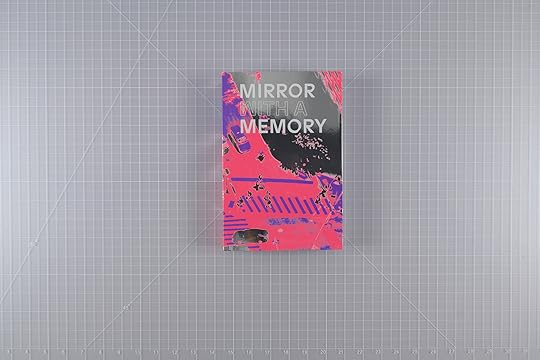
Mirror with a Memory, Dan Leers and Taylor Fisch, eds., Carnegie Museum of Art, Pittsburgh

The New Woman Behind the Camera, Andrea Nelson, ed., National Gallery of Art, Washington, DC

What They Saw: Historical Photobooks by Women, 1843–1999, Russet Lederman and Olga Yatskevich, eds., 10×10 Photobooks, New York
Previous NextAndré Kertész: Postcards from Paris
Elizabeth Siegel
Art Institute of Chicago, Chicago
Bad Ass and Beauty—One Love
Mao Ishikawa
T&M Projects, Tokyo
Mirror with a Memory
Dan Leers and Taylor Fisch, eds.
Carnegie Museum of Art, Pittsburgh
The New Woman Behind the Camera
Andrea Nelson, ed.
National Gallery of Art, Washington, DC
What They Saw: Historical Photobooks by Women, 1843–1999
Russet Lederman and Olga Yatskevich, eds.
10×10 Photobooks, New York
Jurors’ Special Mention: Catalogue as DIY Exhibition

Pass It On. Private Stories, Public Histories, Daria Tuminas, ed., Fotodok, Utrecht, Netherlands, and Meteoro Editions, Amsterdam
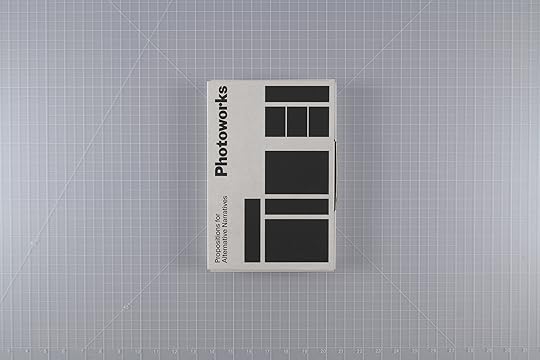
Propositions for Alternative Narratives, Photoworks, ed., Brighton, United Kingdom

Take It from Here, Zora J Murff and Rana Young, eds., There There Now, Columbia, Missouri
Previous NextPass It On. Private Stories, Public Histories
Daria Tuminas, ed.
Fotodok, Utrecht, Netherlands, and Meteoro Editions, Amsterdam
Propositions for Alternative Narratives
Photoworks, ed.
Brighton, United Kingdom
Take It from Here
Zora J Murff and Rana Young, eds.
There There Now, Columbia, Missouri
The 2021 PhotoBook Award winners will be announced during Paris Photo on Friday, November 12, 2021.
September 30, 2021
Announcing the Winning Artists of the Creator Labs Photo Fund
This summer, Aperture and Google’s Creator Labs teamed up to launch a new initiative, the Creator Labs Photo Fund, aimed at providing financial support to photographers in the wake of COVID-19. Selected by Aperture’s editors, the twenty winning artists are recognized for their exceptional vision as well as the strength and originality of their portfolios, and will be awarded a prize of $5,000 each to sustain their work and practice.
The winners of the Creator Labs Photo Fund are:
Daveed Baptiste, Adraint Bereal, Shawn Bush, Jasmine Clarke, Matt Eich, Arielle Gray, Naomieh Jovin, Priya Suresh Kambli, Tommy Kha, Sydney Mieko King, Miguel Limon, Sophie Lopez, Giancarlo Montes Santangelo, Alana Perino, Jade Thiraswas, Bryan Thomas, Maximilian Thuemler, Allie Tsubota, Aaron Turner, and Jasmine Veronica.
Aperture serves as an essential platform for artists, fostering critical dialogue in the photographic community—in print, in person, and online. “We are honored to partner with Google on the Creator Labs Photo Fund,” says Aperture’s creative director, Lesley A. Martin. “Aperture’s team of editors has selected a dynamic and diverse group of photographers, whose talent, vision, and promise are truly inspiring. We all communicate with images today—and we encourage all photographers to continue their practices ensuring a more rigorous, more expansive range of expressions to the field. Together, Aperture and Google are proud to offer these twenty photographers our support, which we hope will be meaningful for their work and careers.”
 Daveed Baptise, from the series Haiti To Hood, 2018–ongoing
Daveed Baptise, from the series Haiti To Hood, 2018–ongoingDaveed Baptiste
In a series of built environments, photographer and fashion designer Daveed Baptiste examines social dynamics in Haitian American life. Drawing from his experience immigrating to and growing up in the US, Baptiste collects and rearranges materials into domestic scenes. “The common home is composed of a series of objects and surfaces within their own state of being, at times symbolizing financial status, choice, and personality,” says Baptiste. Brought together in his series Haiti to Hood, Baptiste’s layered tableaux showcase his subjects as individuals, while speaking to the evolution of their Haitian American identity.
 Adraint Bereal, Untitled, 2020, from the series The Black Yearbook
Adraint Bereal, Untitled, 2020, from the series The Black YearbookAdraint Bereal
Adraint Bereal’s The Black Yearbook combines images and interviews in an effort to share the experiences of Black students at the University of Texas at Austin—where only 5 percent of students identify as Black on a campus of 52,000. Since 2017, Bereal has carried his camera around, photographing moments of communal gatherings and making portraits of his peers. In one image, band members stand in formation with their backs turned to the camera, a choice Bereal explains as an act of “affirming we could hold that space and choose not to face anyone. I like to think of it as giving yourself grace.” For Bereal, this series aims to examine not only the adversity faced, but “the joy of existing in such a place that has historically gone out of their way to keep Black students outside the institution.”
 Shawn Bush, Sublimated Notation, 2020, from the series Angle of Draw
Shawn Bush, Sublimated Notation, 2020, from the series Angle of DrawShawn Bush
Through the lenses of the natural landscape and propaganda imagery, Shawn Bush examines the intersections of power, sustainability, and whiteness in the US. Working in his studio, Bush draws from propaganda imagery from the 1900s, 1960s, and 1970s to create his starkly lit, almost surreal black-and-white photographs. Throughout his process, Bush has considered the impact of the fossil-fuel industry on the natural environment, local economy, and future prospects of those left behind by corporations. The resulting series, Angle of Draw, considers the ways framing imagery impacts the national imagination—upholding systems of social, political, and economic control. “I was thinking about the photographic frame and the ability to crop as a form that censors and advertises,” Bush says.
 Jasmine Clarke, Marissa, 2018, from the series Shadow of the Palm
Jasmine Clarke, Marissa, 2018, from the series Shadow of the Palm Jasmine Clarke
“Myths, like photographs, exist somewhere between truth and fabrication, exactly where I want to stand as an artist,” states Jasmine Clarke. Inspired by a wide range of artists, from novelist Haruki Murakami to filmmaker Djibril Diop Mambéty, each of Clarke’s photographic vignettes transports the viewer into a dreamscape. A shadowed figure stands ominously behind patterned curtains, smoke rises against a fence, an obscured Ludi board’s “Home” is alit with a harsh flash, a single eye peers through shuttered doors. Walking the line between dreams and reality, Clarke’s lushly colored, uncanny images bring together her own disparate strands of familial identity and history. “I see memory and family history as fragmented, pieced together through images, telling multiple overarching narratives of cultural identity,” says Clarke. “Family is also mythology, passed down through generations.”
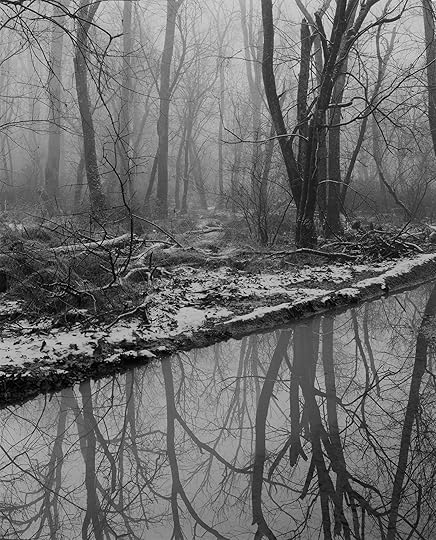 Matt Eich, Untitled, Charlottesville, Virginia, 2020, from the series Bird Song Over Black Water
Matt Eich, Untitled, Charlottesville, Virginia, 2020, from the series Bird Song Over Black WaterMatt Eich
Since 2015, Matt Eich has photographed his home state of Virginia in the ongoing series Bird Song over Black Water. Working with medium- and large-format cameras, Eich documents the natural beauty and brokenness of the landscape, exploring the ways humans have left their mark on the environment. Describing his process as largely intuitive, Eich’s black-and-white photographs simultaneously hold a quality of intimacy and detachment. Informed by the state’s colonial history, the resulting body of work presents a disarming portrait of life in Virginia. As Eich states, “I’m interested in pictures that elicit questions rather than pretend to hold answers.”
 Arielle Gray, Otis’ Room, 2020, from the series Exodus 3:14
Arielle Gray, Otis’ Room, 2020, from the series Exodus 3:14Arielle Gray
Arielle Gray’s photographs beckon to a near mythical surrounding. Her series Exodus 3:14 takes its name from the scripture in which God tells Moses, “I am that I am,” followed by the instruction to state: “I am has sent me to you.” For Gray, this passage is particularly meaningful, as it nods “to a situation in which a group of people are struggling to find peace and salvation.” Photographing her close friends and family as they sifted through ideas of mortality and guilt—from her grandmother burning a catheter, to her uncle Otis’s bedroom and serene portraits of her loved ones—Gray’s work gives us a glimpse into how a group finds everyday deliverance in each other. After all, as Gray notes, “This is a story of many.”
[image error]Naomieh Jovin, The Gathering, 2021, from the series Gwo FanmNaomieh Jovin
The title of Naomieh Jovin’s series Gwo Fanm translates to “Big Woman” in Haitian Creole, alluding to women whose impact on those around them radiates outward. After the passing of her parents, Jovin found herself coming back to this phrase as she explored her family’s origin story. She combines found and original images, audio interviews, and installations into richly multilayered photographs—often featuring the artist’s own direct intervention through colored paper, cutouts, or writing. “I kept in the parts that still complete the narrative and give context to what is taking place in the image while accounting for loss,” she notes. “I’ve always been able to recognize whose body part belongs to who and create this fuller perspective. It impresses me each time, because the picture becomes richer, more vibrant—almost to the point of me being able to imagine the sounds and voices.”
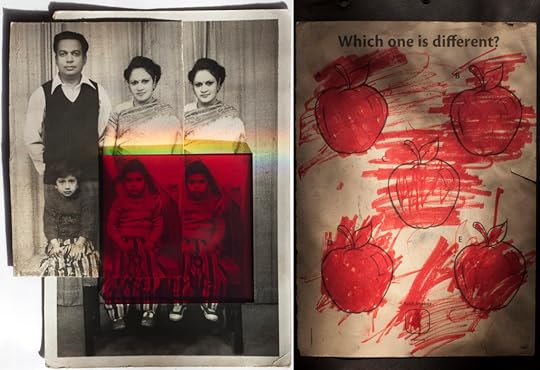 Priya Suresh Kambli, Kambli Family (Studio Portrait) & Which one is different, 2019, from the series Buttons for Eyes
Priya Suresh Kambli, Kambli Family (Studio Portrait) & Which one is different, 2019, from the series Buttons for EyesPriya Suresh Kambli
Pulling from her family’s photographic archive, Priya Suresh Kambli’s series Buttons for Eyes explores cultural hybridization, identity, and migration. Working intuitively, Kambli combines photographs and family heirlooms—such as a letter she and her sister wrote to their father—before concealing elements of the images or drawing out certain features. Through the inclusion of natural light and rainbows created through the use of a prism, Kambli infuses playful experimentation throughout the series. She had asked her husband for the prism for her fortieth birthday, but she initially had difficulty using it. “I literally couldn’t make it work,” she says. “It sat in my studio for two years, and when I picked it up again, it worked, like magic.”
 Tommy Kha, May (A Costume Drama), 2020, from the series Facades
Tommy Kha, May (A Costume Drama), 2020, from the series FacadesTommy Kha
For Tommy Kha, picture-making is tied directly to fragmentation. His series Facades incorporates this concept of fragments in an exploration of Asian American identity and otherness in today’s social landscape. Kha’s playfully experimental images incorporate cardboard cutouts, jigsaw puzzles, paper masks, temporary tattoos, and more, straddling the line between still life, portrait, and self-portrait. Without the use of Photoshop, Kha builds all of his scenes in-camera using a combination of fabricated props, available light, and performance. Leaning into moments of awkwardness, Kha views his work as an aesthetic device to decode, confirm, and validate Asian American identity, stating, “at the moment, there’s quite a bit of space to visualize Asian American narratives and archives, and what that can look like. There’s excitement to see what those pictures can look like.”
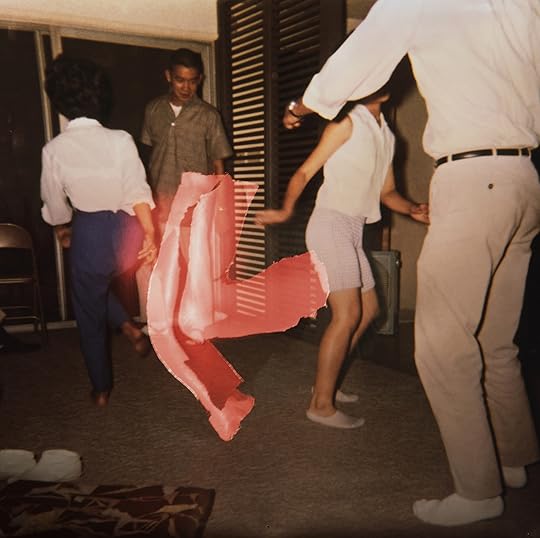 Sydney Mieko King, Redcliff St., 2020, from the series Entanglement
Sydney Mieko King, Redcliff St., 2020, from the series Entanglement Sydney Mieko King
Sydney Mieko King fuses the two- and three-dimensional in her abstracted images layering family archival photographs against plaster molds of her body. Through this intersection, King’s body acts as a container of personal and ancestral memory, as well as a means of exploring her own identity as a mixed-race woman. The plaster molds she creates are attempts at evoking movement and breath, such as a “bend in the stomach, legs wrapped around each other, the overlapping parts of the body.” Ironically, the task of molding herself is an exercise in stillness, in order to prevent the plaster from falling off of her body. “Photography allows me to invent overlaps between my own body and experiences and those of my family. The medium flattens and resolves space,” says King. “The camera’s way of equalizing presence and nonpresence allows me to capture a shifting space in which present and past moments are suspended in time and thus able to interact.”
 Miguel Limon, Al Principio, 2019, from the series Hogares Perdidos
Miguel Limon, Al Principio, 2019, from the series Hogares PerdidosMiguel Limon
When Miguel Limon visited the steel mill where their grandfather worked on the South Side of Chicago, they recalled feeling overwhelmed: “Having known the impact the steel industry has had locally and nationally, it’s a lot to consider how many different histories are tied to the space.” Limon’s series Hogares Perdidos highlights the impact of Latinx and Chicanx immigrants in the Midwest, reconnecting members of the community to their work and grappling with familial memory. Citing LaToya Ruby Frazier and Laura Aguilar as influences, Limon utilizes self-portraiture to insert himself into scenes of family life and labor. Limon reflects, “As a whole, I believe being both in front of and behind the camera allows for an assertion of identity outwardly but also inwardly, providing the liminal space to define my histories and their worldly contexts.”
 Sophie Lopez, At times I forget my mother has existed in the minds of others, 2021, from the series Productions of Chimera
Sophie Lopez, At times I forget my mother has existed in the minds of others, 2021, from the series Productions of ChimeraSophie Lopez
Inspired by I Spy books, Sophie Lopez combines family photos, household objects, and other ephemera into richly layered tableaux. Certain recurring motifs appear throughout her images, from fruit peeled or cut open, to the artist’s hand intervening into the frame, to washi tape—which Lopez uses to represent nonlinear thinking and history-making. Grounded in postcolonial theory, Lopez’s work explores concepts of belonging, power in agency, and the vernacular photo as evidence. “I named this series Productions of Chimera because it felt as though I was rewriting as I saw fit,” says Lopez. “Chimera is defined as an object that is aspirationally longed for but is ultimately illusionary or impossible to achieve.”
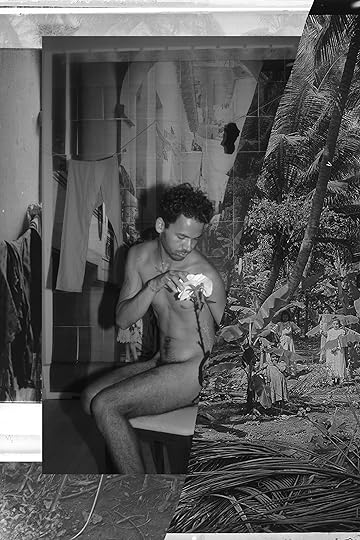 Giancarlo Montes Santangelo, “Young banana plants, growing prospects of a country,” 2021
Giancarlo Montes Santangelo, “Young banana plants, growing prospects of a country,” 2021Giancarlo Montes Santangelo
In an ongoing series, Giancarlo Montes Santangelo traces the effects of colonization in Puerto Rico and Argentina, mapping the relationships between memory, the body, race, and history. Montes Santangelo’s collaged photographs bring together the artist’s own body and staged scenes against archival images from the two countries. “These two archives offer an index of divergent histories that cemented the ways in which many—my family and I included—have had to negotiate with the past, present, and future,” says Montes Santangelo. “Collaging offers me a way to recontextualize archival images and position queer world-making as a method of renegotiating with colonial pasts.”
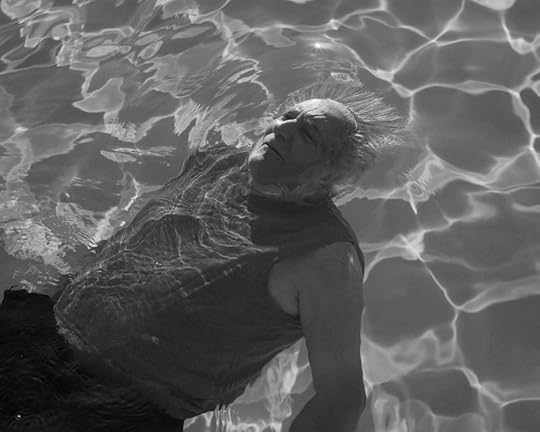 Alana Perino, Dad, 2020, from the series Pictures of Birds
Alana Perino, Dad, 2020, from the series Pictures of BirdsAlana Perino
Alana Perino’s family has often expressed a concern around the “strangeness” of their work. Their stepmother, Letty, was known to ask, “Why don’t you take pictures of birds?” and eventually, Perino accepted her suggestion. “Everything became a bird to me,” they say. “The plants were birds of paradise; my father is a snowbird.” Depicting otherworldly Floridian scenes that confront disparate ideas, Perino’s photographs possess an uncanny quality that collapses the boundaries between the naturally occurring and the staged. Nativity figures shrouded in plastic stand abandoned on the sidewalk, shells gather in memorial around a bathtub, their father floats in a pool with only his face breaking above the surface. Perino finds their images feel most successful when conceptions of “abundance and scarcity, vitality and despair, acceptance and critique become porous or indistinguishable.” Ultimately, Pictures of Birds serves as a remarkable and bitterly affectionate attempt to find strength in the insecurities of heritage.
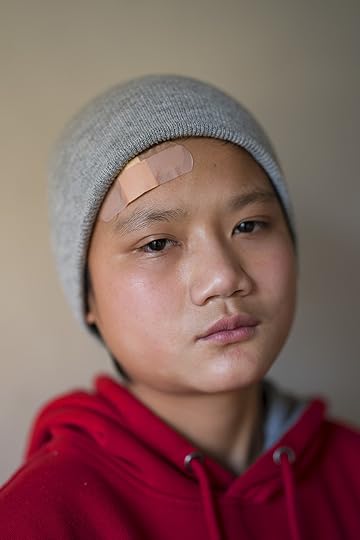 Jade Thiraswas, Portrait of Eh Sun at 14 years old, Rochester, New York, 2018, from the series Young Cash Karen
Jade Thiraswas, Portrait of Eh Sun at 14 years old, Rochester, New York, 2018, from the series Young Cash Karen Jade Thiraswas
Since 2017, Jade Thiraswas has documented a tight-knit community of refugee youth from Myanmar who have resettled in Rochester, New York. The men in Thiraswas’s series are Karen, an Indigenous ethnic minority from Southeast Asia. Thiraswas photographs her subjects in their homes, in the backyard, in traditional clothing and soccer uniforms, offering an intimate look into systems of care and belonging. Yet for Thiraswas, these everyday moments balance against the subtle and apparent effects of globalization, assimilation to American society, and the preservation of an endangered Southeast Asian culture. The series title, Young Cash Karen, refers to the self-chosen name the men formed together. “They proudly use the name to express a sense of belonging and solidarity amongst each other and with the global Karen refugee diaspora,” says Thiraswas. “They retain a sense of unapologetic pride of their identity and history.”
 Bryan Thomas, Mexico Beach, 2019, from the series The Sea in the Darkness Calls
Bryan Thomas, Mexico Beach, 2019, from the series The Sea in the Darkness Calls Bryan Thomas
Each day seems to bring a new alarming statistic about the impact of climate change. Bryan Thomas’s ongoing series The Sea in the Darkness Calls documents the Florida coastline, depicting rising sea levels against present and future changes to its landscape. Rather than exclusively focusing on foreboding research findings, Thomas describes his work as speaking “to the more elemental ways in which our lives—and our physical and spiritual relationship to nature—are being permanently and detrimentally affected.” Photographing the land and sea, and people whose livelihoods depend on them, Thomas searches for the somber truths about the inevitability of loss and the shame of inaction in the face of climate change, asking us to consider how we will respond, not so much in the distant future, but in our present moment.
 Maximilian Thuemler, Self-Portrait Toppled Over Out Back, Glynn County, Georgia, 2020, from the series Born From the Limb
Maximilian Thuemler, Self-Portrait Toppled Over Out Back, Glynn County, Georgia, 2020, from the series Born From the LimbMaximilian Thuemler
Maximilian Thuemler’s Born from the Limb uses the landscape of the US South as a means of exploring relationships between labor, land, and migration. Working in the natural world, Thuemler finds “physical traces of the past . . . in the form of ruins, marks, imprints, vacancies.” Approaching his photographs with a balanced mix of directness and obscurity, these traces materialize as the backdrop for his performances. Throughout his images, Thuemler droops over a tree, wrestles with mud, or repeatedly moves around in circles. These movements highlight a cyclical exhaustion that Thuemler views as analogous to the relationship between the US and its history, stating, “The topic of Blackness and its representation is exhausting, because it is in part infinite.”
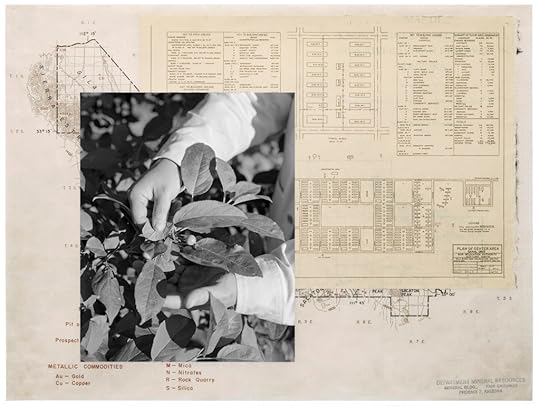 Allie Tsubota, Untitled (Gila River), 2021, from the series This Brilliant Flash of Light
Allie Tsubota, Untitled (Gila River), 2021, from the series This Brilliant Flash of LightAllie Tsubota
Weaving together archival imagery of maps detailing sites of Japanese American incarceration during World War II with black-and-white portraits and seascapes, Allie Tsubota examines how the camera can recall and recover historical relics and psychic refuse embedded in both the landscape and the body. Deploying ideas of migration, racialization, and assimilation, Tsubota’s series This Brilliant Flash of Light traces racial melancholia through the past and present. “How do we resist closure in a society that fetishizes resolution? How do we advocate for reparations while refusing to forget the injustices that warrant them?” Tsubota asks. “To stand in an open wound is to resist the neatening of history—to honor the oceans that continue to live in our bodies, and to adopt a temporality through which our pasts, presents, and futures remain intimately entwined.”
 Aaron Turner, Untitled (self, extended), 2020, from the series Black Alchemy Vol. 3
Aaron Turner, Untitled (self, extended), 2020, from the series Black Alchemy Vol. 3 Aaron Turner
Aaron Turner asks: what is the role of the color black and what is considered Black art? Working in the studio, his constructed scenes consider how the past, present, and future interact in issues of abstraction, race, and history. Influenced by the work of Frank Bowling, W. E. B. Du Bois, and Adrienne Edwards, among others, Turner’s series Black Alchemy explores what “Black art” is and the representation of the Black experience. In discussing the color black, Turner notes “There are different tones, hues, values of black, just like blue or red. Why treat it as secondary?” Seeing it as both material and metaphor, Turner identifies a duality (or double consciousness) that Blackness can inhabit.
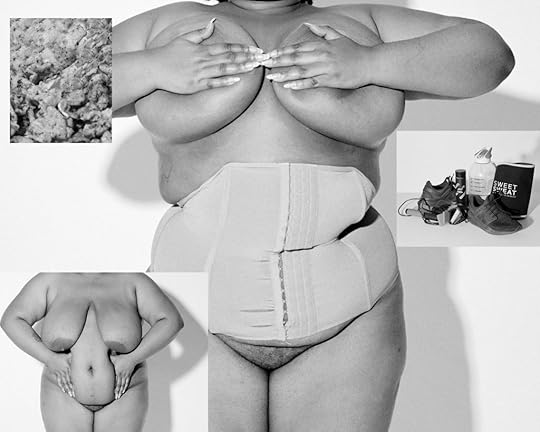 Jasmine Veronica, Snatched Waist, 2021, from the series Guide to a Healthy Body
Jasmine Veronica, Snatched Waist, 2021, from the series Guide to a Healthy BodyAll photographs courtesy the artists
Jasmine Veronica
Jasmine Veronica’s Guide to a Healthy Body critiques societal assumptions around health and wellness. Layering imagery of the body, nature, food, and movement, Veronica’s compositions bring into conversation the ways our health is often blindly defined by outward appearance. In one image, Veronica contrasts two photos—one of herself wearing a waist trainer; and in the second, holding the stomach the trainer is meant to hide—interlaying them against images of food and workout gear. Presented in a uniform black and white, each image has an almost rhythmic quality, reflecting the ways body positivity, diet, and workout culture continuously consume our day-to-day lives. Veronica’s series wonders aloud what it means to be seen as healthy, while reflecting on her own journey through body positivity. “This is something that I’m still trying to find the answer to,” Veronica says. “I would say that I resonate more with body neutrality or anything that allows someone to love themselves without fear of critique and harassment.”
The Creator Labs Photo Fund is presented by Aperture and Google’s Creator Labs. Artist statements by Allie Monck.
September 28, 2021
Visions of Nightlife from Johannesburg to Ibiza
To be in a nightclub. Bodies moving in rhythm. The smells—sweat, cigarettes, that sweet tang of a smoke machine. And the beat. The beat, which rewires your movements, your mind. The sway, the ecstasy of release. In that moment, you are saved.
Such memories have been the stuff of lockdown pipe dreams. It is, therefore, both diverting and bittersweet to browse two recently published books on clubbing—one expansive in its broad geography and history, the other contrastingly specific. Ten Cities: Clubbing in Nairobi, Cairo, Kyiv, Johannesburg, Berlin, Naples, Luanda, Lagos, Bristol, Lisbon 1960–March 2020 (2020) is an ambitious record of these select music scenes. Dave Swindells’s Ibiza ’89 (2020) brings together images Swindells made on a short magazine assignment in the summer of 1989, sparked by the influence of the island on the U.K.’s then thriving acid house and rave scenes, known as the Second Summer of Love.
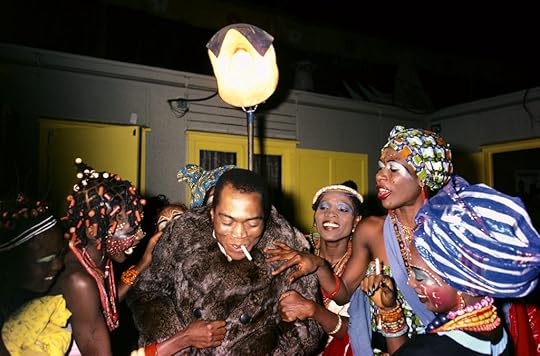 Bernard Matussiere, Fela Kuti with the queens, Stratford, London, 1983
Bernard Matussiere, Fela Kuti with the queens, Stratford, London, 1983Courtesy the artist
The books take distinct, even opposing, views. Ten Cities tries to push against the idea that clubbing is a frivolous or universal experience, citing, through exhaustive essays from various international figures, the political, economic, geographic, and local particularities of various nightlife scenes. Clubs, the book’s editors Johannes Hossfeld Etyang, Joyce Nyairo, and Florian Sievers explain, are “prisms and laboratories of society and the city.” Ten Cities centers Africa’s music and culture, and makes 1960 the narrative starting point because that was when independence swept the continent. “As a general rule, the history of club culture is told without the African musical metropoles,” Hossfeld Etyang writes. The authors position Nairobi as their project’s home—a vivid picture is painted of the Starlight nightclub where Barack Obama Sr. danced in the 1960s—before veering off to other cities, chosen in an attempt to disrupt established ideas of certain cities as clubbing meccas and others as backwaters or slums.
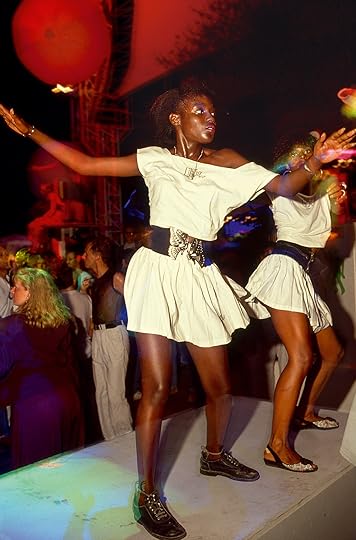
Dave Swindells, Go-go dancing superstars at Ku, 1989, from Ibiza ’89
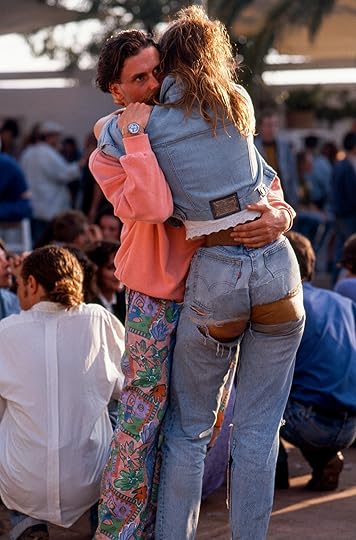
Dave Swindells, Hug club: celebrating making it through the night
(just about) at Amnesia, 1989, from Ibiza ’89
Amusingly, Ibiza ’89 does everything Ten Cities tries to avoid; it is Eurocentric and fawning (Ibiza, we learn, is “Europe’s best party island,” according to the music producer Terry Farley), and it paints clubbing as hedonistic and vaguely manic, focusing on the young, the beautiful. Still, the photographs are lovely to look at.
In the 1930s, the South African musician and author Todd Matshikiza, then a young boy, attended a party thrown by the musician Boet Gashe, an event he recalled in 1957, in Drum magazine: “You saw the delirious effect of perpetual motion. . . . Perpetual motion in a musty hold where man makes friends without restraint.” The line, which captures the heady feel of clubbing, the existential epiphanies found in ephemeral places, could be a description of any one of the photographs of gyrating revelers in Ibiza ’89, but it is quoted in Ten Cities. Its inclusion there highlights the challenge of analyzing, or indeed photographing, club culture. How does one balance a focus on the shared and at the same time on the specific, the local, the “scene”?
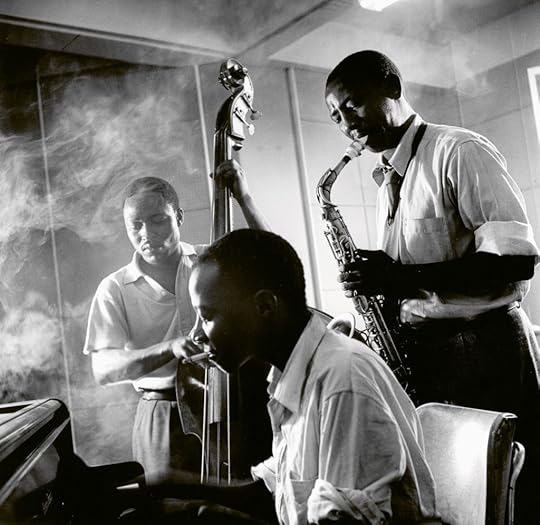 Jürgen Schadeberg, The Jazzolomos: Jacob “Mzala” Lepers (bass), Sol “Beegeepee” Klaaste (piano), and Benni “Gwigwi” Mrwebi (alto sax), Johannesburg, 1953
Jürgen Schadeberg, The Jazzolomos: Jacob “Mzala” Lepers (bass), Sol “Beegeepee” Klaaste (piano), and Benni “Gwigwi” Mrwebi (alto sax), Johannesburg, 1953© the artist
 Mosa’ab Elshamy, Mahraganat, Cairo, 2013
Mosa’ab Elshamy, Mahraganat, Cairo, 2013Courtesy the artist
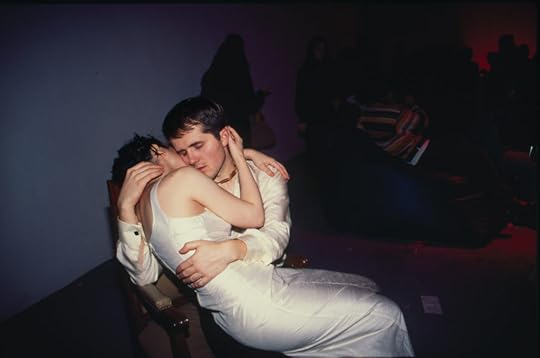 Frágil birthday party at Convento do Beato, Lisbon, 1996
Frágil birthday party at Convento do Beato, Lisbon, 1996Courtesy LuxFrágil
It is notable that so many astounding clubbing photography projects exist—for example, Tod Papageorge’s Studio 54 or Tom Wood’s Looking for Love. Yet nearly all work around familiar themes: beauty, sex, and glamour, peppered with moments of sexual rejection and flashes of exhaustion. Ten Cities is smart in not scrupling to celebrate these familiar elements, while simultaneously homing in on the unexplored, the theoretical, the minutiae. We are reminded that clubs are shaped not just by dancing bodies and good DJs but also by transport links, alcohol taxes, parking spaces, coups, elections, and governments. Yet gems by Jürgen Schadeberg and Tobias Zielony lend a “God, to have been there” air and offset some of the more intensive academic positing.
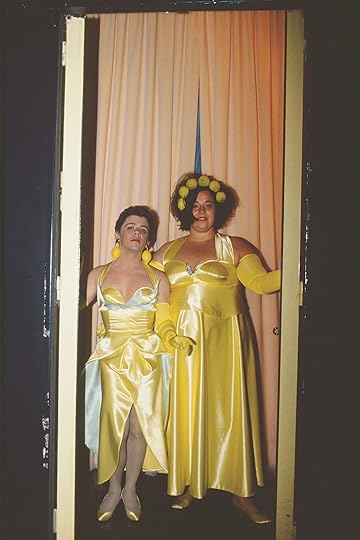
Margarida Martins and Mário Marques, Absolut Citron Party, Frágil, Lisbon, ca. late 1980s
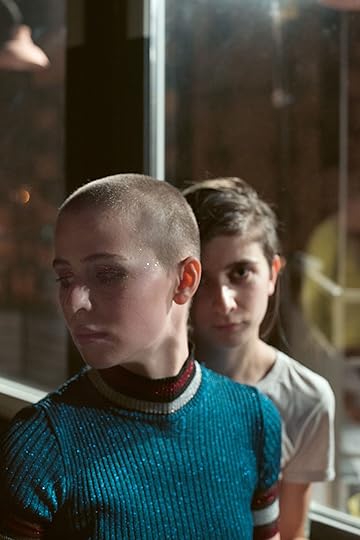
Tobias Zielony, Shine, from the series Maskirovka, Kyiv, 2017
Courtesy the artist and KOW, Berlin
For those convinced that COVID-19 has decimated nightclubs, it will be uplifting to remember that they have survived big trouble in the past, be it a monthlong, dusk-to-dawn curfew in Nairobi in 1982, regulations that banned amateur bands in Kyiv in the early 1970s, or ad hoc surveillance, such as that of Fela Kuti, whose growing popularity with Lagos crowds briefly irked the Nigerian government, which, ironically, raided him right ahead of FESTAC ’77, a landmark international festival celebrating African culture.
If Ten Cities encourages reflection, Ibiza ’89 thrills to escapism, embracing the cliché of sun, sea, sand, and sex—the gaze on a thong-clad bottom, the close crops on beautiful youths, the sweat on an entangled couple. It is a fascinating lesson in how myths are made, how rose-tinted glasses are applied. In the book’s introduction, Swindells recalls how clubbers on the island would tell him that 1989 was too late, he should have come earlier: “You’d have loved it here in 1987!”
 Dave Swindells, The bold and the beautiful: great pattern clashing from Boy George and the gang at Amnesia, 1989, from Ibiza ’89
Dave Swindells, The bold and the beautiful: great pattern clashing from Boy George and the gang at Amnesia, 1989, from Ibiza ’89All photographs by Dave Swindells courtesy the artist
And yet, despite Swindells’s mocking tone, his book is driven by the same nostalgia, proffering the idea that those were the glory years, that later, in Farley’s estimation, the scene “lost its character.” The beauty of the pictures and the hazy memories tussle with the reality briefly alluded to in Alix Sharkey’s 1989 essay, produced on the same commission as the images, with its smattered references to burnout, addiction, and local distress. But today’s zeitgeist is nostalgic too. Just weeks after its publication, Ibiza ’89 sold out, trading for triple the price on fashion resale sites—evidence of the current thirst for the retro in fashion, photography, and, most visibly, on Instagram. Still, how appropriate. As both Ten Cities and Ibiza ’89 show us, great clubs cannot exist without some nostalgia, without the sense of time slipping away, without FOMO, without the intoxicating promise of unrepeatable experiences, all bolstered by fables and hearsay.
This article originally appeared in Aperture, issue 244, “Cosmologies,” under the column “Viewfinder.”
September 22, 2021
A Japanese Photographer’s Bittersweet Archive of His Late Wife
Seiichi Furuya, based in Graz, Austria, for almost fifty years, is an established member of the European photo community and cofounder of the esteemed journal Camera Austria International. But his departure from his native Japan to his adopted country of Austria is not widely known. At the end of September 1973, Furuya left from Yokohama on a Soviet cargo ship, arriving in Vienna in early October. Furuya had been a student of photography at Tokyo Polytechnic University during an increasingly turbulent time in postwar Japan. Between the university riots, the anti–Vietnam War movement, and the anti–Japan-US Security Treaty movement, Tokyo was like a battlefield. Furuya frequently participated in the demonstrations with his camera. But as the movement cooled off, realizing that there was no longer a place for him in Japan, he burned his negatives and left.
Furuya moved to Graz two years after his arrival in Vienna and soon connected with other photographers. He became a founding and active member of Fotogalerie im Forum Stadtpark, an artist cooperative organizing exhibitions and occasionally planning workshops with photographers, including Mary Ellen Mark and Ralph Gibson. In 1979, the group started the inaugural Symposion über Fotografie (Symposium on Photography), which occurred annually until 1997. The inaugural three-day symposium included participants such as Lee Friedlander, Robert Heinecken, Joseph Kosuth, and John Szarkowski. Furuya also served as liaison to many key Japanese photographers working at that time, including Shomei Tomatsu, Daido Moriyama, Masahisa Fukase, Miyako Ishiuchi, and Nobuyoshi Araki, helping many of them set up their first exhibitions in Europe. Around the same time as the launch of the symposium, Furuya collaborated with Manfred Willmann and Christine Frisinghelli to launch a new magazine, Camera Austria, the first issue of which was published in 1980.
Face to Face is the sixth volume of work Seiichi Furuya has published under a variation of the title Mémoires (1989, 1995, 1997, 2006, 2010). Unlike with the other five books, Furuya shares equal authorship in this edition: Christine Gössler’s gaze at Furuya, and his gaze at Gössler, intersect through photographs that each made of the other. While Furuya continues to work with the materials created during Gössler’s life—like an ongoing body of work that resulted from a trip they took to Bologna, among other images from their life together—he has stated that this is the last of the Mémoires variations. In these works, Furuya challenges us to think about what it means for an artist to go so deep into a single, emotionally charged body of work, made so long ago and revisited time and time again.
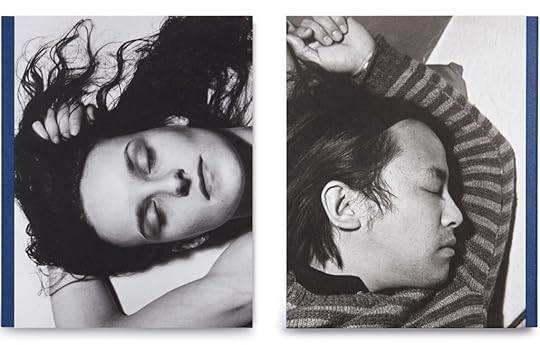 Cover and back of Seiichi Furuya and Christine Gössler, Face to Face (Chose Commune, 2020)
Cover and back of Seiichi Furuya and Christine Gössler, Face to Face (Chose Commune, 2020)Yasufumi Nakamori: Face to Face [Chose Commune, 2020], published last year, is the first entry to the Mémoires series in ten years. Before diving into Face to Face, please tell us how you left Japan for Austria in the early 1970s and what you were doing before that in Japan.
Seiichi Furuya: At the end of September 1973, I left Japan from the Port of Yokohama on a Soviet cargo ship called Khabarousk and arrived in Austria’s capital Vienna in early October, along the way passing Nakhodka, Khabarovsk, and Moscow. Around 1970, I was a student photographer in Tokyo during what was known as a turbulent time in postwar Japan. Between university riots, the anti–Vietnam War movement, and the anti–Japan-US Security Treaty movement, Tokyo was like a battlefield. I was around twenty years old at the time. Although I didn’t belong to any particular group, I was one of those people who frequently participated in the demonstrations. For me, bringing my camera and taking photos did not preclude me from participating in the demonstrations. The highly charged atmosphere of the society gradually cooled off as the Japan-US Security Treaty was set up to renew automatically. When the turbulence ended, I started realizing that there was no longer a place for me in Japan, and that thought grew stronger over time. I had a friend who had left Japan earlier and was living in Vienna at the time. Eventually I left Japan under the pretext of visiting this friend. After spending two nights on the ship, we docked at Nakhodka. The moment I stepped onto the land, I thought to myself that I was probably never going to return to Japan. Right before leaving Japan, I burned all the photographic records of my bustling life in Tokyo.
 Christine Gössler, Graz, 1979
Christine Gössler, Graz, 1979Nakamori: Graz has been the base of your creative activities for forty-five years, during which you cofounded Camera Austria. When and for what reason did you move to Graz? Please talk about how you arrived at co-founding Camera Austria, especially your involvement with Symposion on Photography.
Furuya: After staying in Vienna for two years, I moved to Graz, which is the second largest city in Austria, and I have been here since. The biggest reason for the move was that I got a job at a camera store in Graz through an acquaintance whom I came to know through photography. While working at the store, I came to know others who shared interest in photography and eventually became a founding and active member of Fotogalerie im Forum Stadtpark, an artist-based voluntary organization. In the beginning, we organized about ten photo exhibitions a year and planned workshops of famous photographers from time to time. Some notable workshops that I attended include ones for Mary Ellen Mark and Ralph Gibson. Three years ago, I found in the attic some black-and-white Super 8 film, which had detailed footages of Mark’s workshop from 1979. In the fall of 1979, we started the inaugural Symposion über Fotografie [Symposion on Photography]. We invited a dozen or so guests from around the world who were active in photography and hosted a three-day symposium.
Americans including Lee Friedlander, Robert Heinecken, Joseph Kosuth, Allan Porter, and John Szarkowski also attended the symposium. As part of the brain behind the whole operation, Christine Frisinghelli was involved with the founding of both the organization as well as Camera Austria International. She was in charge of all the negotiations and translated the inadequate words of those of us who were self-claimed photographers into something beautiful. I remember it as if everything happened only a few days ago… driving to the airport to pick up Friedlander and Szarkowski, working on a draft version of what was going to be published about the symposium, Friedlander used a handmade lightbox which was stored in the darkroom up in the attic to copy slides he brought for the lecture. At the time, for Europeans and Japanese, the mecca of photography was America. Instead of us going over to America, we invited folks who were active on the frontline of photography in America to come over and it was a huge success. For the inaugural symposium, we also invited Shoji Yamagishi from Japan. Unfortunately, he passed away while still corresponding with me to finalize his lecture. Szarkowski paid tribute in front of his portrait at the symposium.
We hosted the Symposion on Photography every fall for seventeen years until 1997. In charge of Japanese affairs, I worked with Shomei Tomatsu, Daido Moriyama, Masahisa Fukase, Tsuneo Enari, Miyako Ishiuchi, and Nobuyoshi Araki, and probably helped many of them set up their first show or solo exhibition in Europe. While working on the symposium, we started planning for the publication of a photography magazine. Manfred Willmann of the organization and I worked on initial drafts of the new magazine while referencing the latest Japanese camera magazines that were getting delivered to my place every month. In 1980, the first issue of Camera Austria was published. At first, we thought about using our own photos and publishing the magazine under issue 0 as a pilot. Before we knew it, the magazine was published as the inaugural issue. I think it’s worth mentioning the origin of the name of the magazine: When contents of the first issue were mostly decided, we held a meeting in the basement of Forum Stadtpark to decide on its name. Six or seven members put forward their proposed names, but none of them got a decisive yes from the group. At the time, an acquaintance of mine who also left Japan, and was in the middle of his own wandering journey, shouted out the name “Camera Austria.” No one objected. I think that over the years Symposion on Photography has provided a platform to discuss and demonstrate the evolving definition and meaning of photographic expression through real-life examples. Meanwhile, Camera Austria continued to grow while keeping pace with changes that were happening at the symposium.
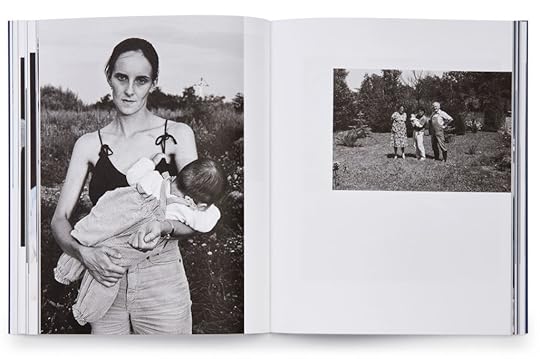 Spread from Seiichi Furuya and Christine Gössler, Face to Face (Chose Commune, 2020)
Spread from Seiichi Furuya and Christine Gössler, Face to Face (Chose Commune, 2020)Nakamori: Please tell us how you met Christine Gössler, your life partner and a coauthor of Face to Face, who tragically took her own life in 1985.
Furuya: In February 1978, at Forum Stadtpark, I met Christine for the first time at the opening of a solo exhibition by Gwenn Thomas called Color Photographs. Christine came with another woman who was a mutual acquaintance of both Manfred Willmann and mine. Ten days later, I mustered up the courage to call her and asked her to watch a movie together. We saw the Japanese movie Harakiri. From that day on, our lives became inseparable. Looking back, I realize that our relationship started with a movie about suicide, and ended with her own suicide. In mid-March of that year, we went to Bologna for a week. According to her notebook, I made up my mind to marry her while we were in Bologna. One week after returning from Bologna, I went back to Japan for the first time since 1973 and Christine came with me. During our two-month stay in Japan, we took part in a Shinto-style wedding ceremony at my home in Izu, and with that our relationship quickly moved on to the next level. Thinking back, it may have been the happiest time for us, although she seemed a bit caught off guard by the sudden change in environment. Shortly after returning from Japan, I quit my job at the camera store and started a new phase of life without a regular job. Christine was aiming to complete her thesis at university, but she eventually gave up and started working for the Austrian National Broadcasting Corporation.
There is an old passage that I wrote that describes, in simple terms, our encounter and how I felt about her. The passage was included alongside a portrait of Christine in the first issue of Camera Austria in 1980. It implied a deep connection between the human encounter and the characteristics and essence of photography as an expressive medium. So much so that it wouldn’t be strange to say that the passage could also have been written for Face to Face, published in 2020.
From the first day I began taking photographs of her regularly. I have seen in her a woman who passes me by, sometimes a model, sometimes the woman I love, sometimes the woman who belongs to me. I feel it is my duty to continue to photograph the woman who holds so many meanings for me.
When I consider that taking photographs means fixing time and space, then this work—the documenting of the life of one human being—is exceptionally thrilling for me. In facing her, in photographing her, and looking at her in photographs, I also see and discover “myself.”
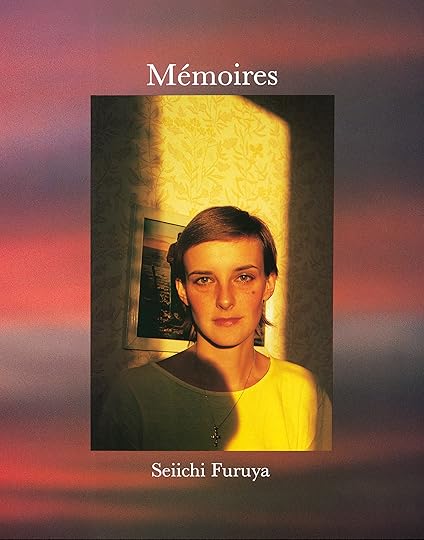
Seiichi Furuya, Mémoires 1978–1988 (Edition Camera Austria, 1989)

Seiichi Furuya, Mémoires 1995 (Scalo/Fotomuseum Winterthur, 1995)
Nakamori: After Christine passed away, you edited and published several different editions of Mémoires featuring photographs from her life. I was wondering if all of that might have helped you get to know her better.
Furuya: In 1981, our son was born. Around the summer of 1982, the three of us left Graz and moved to Vienna. By that time, Christine had already started producing her own radio program at the Austrian National Broadcasting Station. One day, out of the blue, she said to me, “I want to be an actor. I want to be on the stage. It’s a dream I’ve had since I was a kid.” I was against it. After having lived together for four years by then, I honestly didn’t think she had what it takes to get through all the hardship that’s necessary in order to become an actor. I thought I knew her sensitive and compassionate personality. I thought I knew how, despite her modesty and tendency to not show her true feelings and thoughts, she was the type of person who would devote herself completely to something. However, as someone who didn’t have a job with steady pay and was at the mercy of Camera Austria, I strongly felt responsible for the impoverished life my family was going through, and thus I couldn’t convince her otherwise. When she started taking private lessons in order to matriculate at a theater college, Christine became like a shell with a closed lid and stopped talking to me about not just theater, but also things in her daily life. This lasted until her final day in Berlin in October 1985. It wasn’t until 2005 that I became fully aware that she was dealing with theater and other problems in her life alone.
Nakamori: Please tell us how Face to Face came about. You published five photobooks from 1989 to 2010 under the title Mémoires (all with Christine as subject). What’s the relationship between those five books and Face to Face?
Furuya: In the summer of 1987, I went back to Graz from East Berlin. It was when I started organizing her belongings that I discovered her notes. But I didn’t have the courage to read them right away. I was afraid that it was something that I either couldn’t bear to know or didn’t need to know. The notes were handwritten in German, so it wasn’t like I could easily read and understand them anyway. If they were written in Japanese, I’m sure things would have been different. It wasn’t until almost twenty years after her death, around Christmas 2005, that I finally decided to find out what the notes were about. I asked a girl who was a total stranger working part-time at the Graz Art Museum to reproduce a clean copy of the notes. I read and reread that clean copy carefully during a two-month stay in Paris. I hadn’t hid any secrets from Christine and always thought that I was living a straightforward life. However, Christine’s notes revealed that she’d become obsessed with theater and was increasingly struggling with her own limits while dealing with her mother and our child. I was shocked to read that at some point, she thought her theater instructor had become the only person who could forgive her, like a true mother. I didn’t know any of this, and it was as if I was reading about a different person. For me, the expressive power of her notes was beyond what photography could achieve. There were quite a few parts of her notes that even the female student who reproduced the clean copy couldn’t fully understand. In 2006, I published the fourth edition of Mémoires [titled Mémoires 1983] using portions of her notes along with photos.
After Christine killed herself in East Berlin in 1985, I worked there for two more years, finishing my job as an interpreter. In the summer of 1987, I returned to Graz to reunite with my son. On June 12, 1987, President Reagan delivered his “Tear Down This Wall” speech to Gorbachev on the west side of the Brandenburg Gate, which was also a symbol of the division between East and West Berlin. I listened to the speech along with many Stasi, National Secret Police of East Germany, on the east side of the gate. Of course, for someone who always carried a camera, I took photos of this historic occasion. Although at the time, no one, including probably President Reagan himself, foresaw that just two years later the Berlin Wall would come down along with the collapse of East Germany. In 2010, the fifth and final volume of Mémoires was published, which documented our lives moving from Dresden to East Berlin in 1984 and up until my return to Graz in 1987.
In 1989, my solo exhibition was held at the Neue Galerie Graz [the state museum of modern art in Graz]. The first edition of Mémoires was published at the same time. Meeting the museum director to discuss the name of the exhibition, I suggested a few names, such as Travelogue. But it took a while for us to agree. Eventually, the director said that what I was thinking about and trying to do would fit well with the French word mémoires. Thus, the name of the exhibition and my photobook was born. The exhibition was supposed to be important for both commemorating Christine and for sorting through my own feelings. It toured Vienna and Tokyo, and in the midst of changing venues, I felt that something new was stirring inside me. This feeling first came about when the 1995 edition of Mémoires was published, and lingered over the course of publishing the 1997 and 2006 editions, and even when I published what was meant to be the final iteration of Mémoires in 2010.
I publicly announced, at my solo exhibition at the Tokyo Metropolitan Museum of Photography [formerly the Tokyo Photographic Art Museum] in 2010, that this would be the final publication in the Mémoires series. I felt that no matter how many times I tried with the publications of these photobooks, I didn’t really understand anything new. At the same time, I wanted to work on a book of my works that were not directly related to Christine. However, I had a stroke just before the exhibition in Tokyo, and it took me at least five years to recover. Since the announcement in 2010, I avoided works related to Christine and spent my days away from photography to focus on recovering my health.
 Seiichi Furuya, Mémoires 1983 (Akaaka Art Publishing, 2006)
Seiichi Furuya, Mémoires 1983 (Akaaka Art Publishing, 2006)Nakamori: What brought you back to photography and back to the world of Mémoires?
Furuya: Something came along out of the blue. At the end of 2017, the director of a photography museum in Japan reached out to me about doing a solo exhibition. While on the phone, I had this sudden feeling that I was being pulled back into the world of Mémoires. I was surprised, as I had been avoiding it until then, but the feelings just rushed in as if bursting through a dam. But this time, there was a definitive difference from the previous books, as I thought about presenting mainly works done by Christine herself for the exhibition. With only a few exceptions, the different editions of Mémoires had mainly presented photos that I took of Christine. Over the years, I was consumed with my own works, and I didn’t realize that Christine was a creator in her own right, with works expressing herself, until some thirty years after she passed away. To prepare for the exhibition, I started organizing her belongings, which had been stored in the attic for decades. I found her writings, Super 8 footage, cassette tapes, 110 film—things that I had forgotten about or saw for the first time. There was a reversal film of me standing behind a tripod with a 6 by 7 camera, which was taken on the coast of my hometown of West Izu in 1978. Christine must have taken that picture while I was taking a portrait of her standing on the edge of the cliff, with a Leica camera strapped around her neck, wearing tall, black rubber boots and carrying a bamboo stick. I was excited to have discovered this and found myself uttering the words “face to face.”
I arrived at Face to Face after going through five volumes of Mémoires. In a sense, my photos in each of those books are the starting point to make sense of the tragedy and mystery of the woman that is Christine. It was difficult for me to dismiss her death simply as a result of schizophrenia, which is a standard response given by society these days. Some friends tried to comfort me by using this standardized response. But after going through trial and error for over twenty years, the sad truth remains that I still don’t fully understand why it happened. Finally, with Face to Face, at least Christine can be recognized as a creator herself. It’s another volume of Mémoires, with her being credited as the author of her own works.
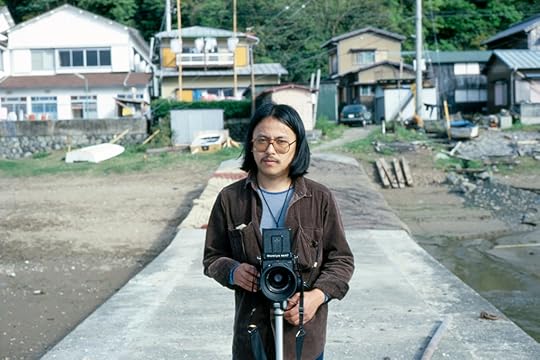 Christine Gössler, Izu, 1978
Christine Gössler, Izu, 1978Nakamori: A key difference between Face to Face and your other works is the alternation between photos you took of Christine and photos that she took of you. Please tell us about the challenges of making and editing a photobook that focuses on the intersection of two creators.
Furuya: I was hoping to find more photos that Christine took. As if answering my prayer, I found 110 film negatives that I didn’t know existed, as well as color negatives from a 35 mm camera from when she started taking photos again in 1985. Eventually, it became clear that Christine was often taking pictures of me, and that we were taking pictures of each other at almost the same time. The act of taking photos and having our own photos taken continued, with varying frequency, until the day before she took her own life. On top of that, the hardest part was finding myself in my own photographs. I carefully checked the photos that I took from the time I first met her until I lost her, because sometimes she took photos of me with cameras that I was using. I made prints from selected films, arranged them in chronological order, and started to look at them carefully. The exhibition hall for Camera Austria was an ideal place for doing so. When viewed side by side, the prints were about twenty meters long. Just when the prints were completed such that they would fit nicely with the layout of the venue in Japan, we heard the news that the exhibition had been canceled. At the beginning of 2019, I immediately switched from planning an exhibition to planning a photobook, and carried on working. At that time, after having finished the selection of photos and arranging the material in chronological order, I selected the Marseille-based Chose Commune to be the publisher. I was told that Cécile Sayuri Poimboeuf-Koizumi was the editor in charge, and I entrusted the production of the book to her. If the editor wasn’t a woman, I’m not sure that I could have entrusted the whole process to someone else. Instead, I was completely hands-off.
I was shocked when I viewed the printed photobook for the first time in December 2020. After opening the cover and going through the pages, I almost felt that the two people in the book were talking to each other. It was like traveling back in time and space. I didn’t realize this when I was still preparing for an exhibition. I’m sure it has a lot to do with the binding of the photobook and the layout of each page. When the book is closed, the two people are still and facing each other, just like the title, face to face. But when you turn the pages, it’s as if a switch has been flipped, and the two people start to move and talk to each other. I reread the book and it felt the same every time. Maybe it’s something only I can experience, since I know the background of the photos. I also thought that might be what it means to have a book of moving pictures for adults. Some might simply think that what’s happening here is two people staring at each other and trying to read into the meaning of each other’s facial expressions, but one should be mindful that such reproduction of the act of staring is only made possible by the incredible invention of photography. Capturing a momentary image is one of the most salient characteristics of, and the original purpose of, photography. In that sense, what you see in terms of two people’s facial expressions satisfies that aspect of photography very well. But I can’t help but feel that those photos also express something beyond that. This is something that one becomes aware of only after a photo, which captures a past reality, is taken, and it’s something that is almost impossible to experience in real life. Even on the occasions when we take photos of each other, everything is a series of moments that keep changing. The moments when we stare at each other are so fleeting amid the passing flow of time that it is impossible to consciously read into and interact with each other mentally there and then. Photography is the only expressive medium through which we can relive and reconfirm a moment from the past. In that sense, I think Face to Face is a perfect embodiment of the magic of photography.
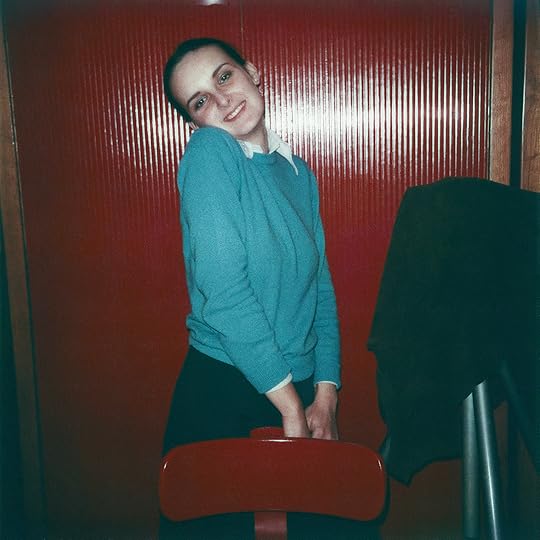
Seiichi Furuya, Graz, 1978

Christine Gössler, Graz, 1978
Nakamori: What does the act of taking photos mean to you? What does making and publishing photobooks mean to you?
Furuya: While thinking about how to respond to this question, I realized that I had never thought about the meaning of taking photos. I just always took photos before thinking about meaning or purpose. But for the last ten years, I haven’t taken many pictures. The reason is simple—things are less visible to me now, and my inner desire and need to take photos are not what they used to be. I think one of the reasons is that I have had almost no chance to expose myself to the vicissitudes of today’s world, and the lifestyle or habit of always carrying a camera with me wherever I go has largely gone away. For a while, I was taking pictures with a digital camera for blogging. Starting about a year ago, I’ve been taking photos of my grandkids and the change of seasons in my garden with my mobile phone. But at the end of the day, for me, a photo is a copy of reality printed on film that can be touched by hand. I have no interest in creating “artworks” using the medium of photography. For me, photography is the act of quickly capturing an image that approximates a premonition we feel when encountering moments of anxiety or interest in daily life. In my case, it can also be said that the act of taking photos, instead of, say, writing, is a way for me to record my impression and experience of encountering things that I can’t comprehend even through imagination, but is somehow connected to my existence. I’ve been called a “boundary” photographer by some. In fact, one of my works is called Boundary and I took photos of the Berlin Wall, but many portraits of Christine also portray the boundaries between people. It doesn’t matter if the quality of a photo is good or bad; it is no longer my concern in the moment it’s taken. Then, when it revives with the passage of time, it becomes the first time for me to face a photo that I once took.
I think that making a photobook is like assembling chaotic and complex images toward one big theme in your head. As the work progresses, the outline of the theme becomes clearer. I think it might be similar to how a composer writes a symphony by combining individual notes. For me, with the exception of my first photobook, AMS [Edition Camera Austria, 1981], I keep making photobooks so that I can bring them along with me when I eventually meet Christine again. Maybe they can also be called reports. There is another important reason why I keep making these photobooks—it is to tell our son and our grandchildren what kind of a person she was in ways that I could never do with words. The day after Face to Face arrived from Chose Commune, I brought it with me to the front door of my son’s house. There were strict rules in place related to the novel coronavirus. My son was fearful that I might contract the virus from my grandchildren, so we didn’t see each other. It seems that my son was more worried than I was about older folks getting infected. In Face to Face, my son showed up on many of the pages. Since this was his first time seeing these photos, I wasn’t sure how he would react. I was told that later that night, he read the photobook with his eldest daughter, who was six years old at the time. They seem to have enjoyed the book, and he was asked a lot of questions. My granddaughter was a little confused at first since her grandmother, Christine, looked youthful in those photos.
Now that I’m over seventy years old, I feel that I don’t need to hide anything anymore. There are a few reasons why I’ve published photobooks and portraits of Christine again and again over the years, but there’s one key reason that I’ve never publicly stated. That is, I want to help accomplish her childhood dream of standing on the stage—a dream that tormented her and may have forced her to kill herself. For example, the San Francisco Museum of Modern Art and MoMA in New York have collected several photos of her, and her portrait on the coast of Izu in 1978 was just exhibited at the Metropolitan Museum of Art. Seeing her smile at me with that same bamboo stick, this time in New York, I couldn’t help but go up to the photo and talk to her. I never thought I could meet her again in such a place. I will continue to publish works of her and works by her, all of which always contain my unwavering desire to give my deceased wife an eternal life.
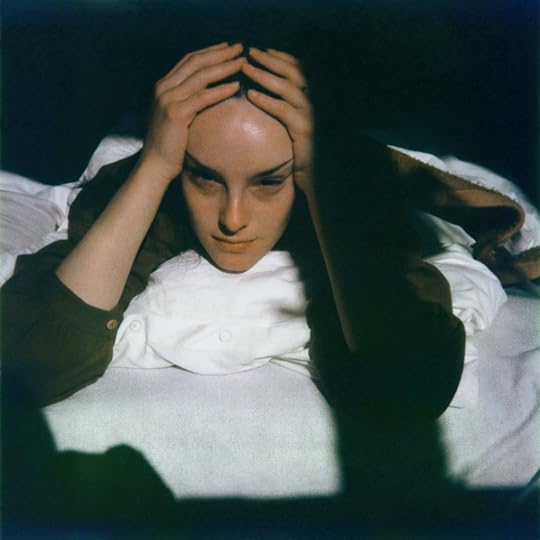 Seiichi Furuya, Graz, 1979
Seiichi Furuya, Graz, 1979All images courtesy the artist and Chose Commune
Nakamori: What do you think about COVID-19 and the resulting lockdown of cities and nations from last year to the present day? Also, please tell us what you are currently working on or would like to work on in a situation like this.
Furuya: It has been exactly one year since measures to battle COVID-19 were issued here in Austria [as of March 2021]. It actually has been a very fulfilling year for me. Thanks to the lockdown, I was able to focus on work that required a lot of patience and concentration. From the non-stop and inescapable news cycle about the virus, the idea that has related to me the most is death. From the moment of birth, a person begins their journey toward death. Yet, for a period of time, there is no need to think about the idea or meaning of death, so one is not aware of death and thinks that death has nothing to do with them. One might even think that they can live forever. After the age of seventy, death creeps into our life on many more occasions, while the eventuality of our own death remains ever more present. In my case, death is neither unpleasant nor frightening, and recently I’m even starting to feel that confronting death can make one feel refreshed. There is a tall gingko tree in my garden. I used to totally ignore its existence. These days, I watch the tree change throughout the seasons and think about the fateful encounters in life. Some of us live to be thirty-two years old, others to seventy-something years old, and yet others to a thousand years old (since I was a child, I’ve heard that gingko trees can live to be a thousand years old). I spend my days meditating on the trajectory and stories of my life, while being amazed at the small miracle that I got through all the trials and tribulations in my life since leaving Japan, and that I’m still around. Since we are still required to refrain from social activities to fight the virus, this is not a bad way to spend my otherwise solitary life.
At the moment, I’m getting started on the production of a new photobook called First Trip to Bologna. The book consists of materials from our trip to Bologna shortly after I met Christine in 1978. I plan on using only frames from videos taken with a Super 8 camera instead of the still photos that appear in this book. I also found this film in the attic and was very surprised when I watched the digitized film on a screen. No matter how many times I watched the video, I couldn’t recollect memories from the trip. It got to the point where I doubted if I was even there with her. It’s as if days that I didn’t know existed were brought back and recreated in front of me. Since I don’t remember anything, I thought about creating a brand-new story of the Bologna trip for us. In addition, I would like to publish a collection of photos taken solely by Christine. I wonder which project would come first, but I hope to bring this photobook with me as a souvenir when I see her again. I want to leave behind records of Christine’s works for our son and his kids. For me, the days of taking photos are mostly over. From this point on, I think my job will be to work with the newly discovered materials belonging to Christine and bring them to the public as her own works as much as possible. Other than that, I would probably continue to take family photos of my son and grandchildren with a 6 by 7 camera from time to time.
Nakamori: Thank you very much.
This piece originally was published in Issue 019 of The PhotoBook Review. Translated from Japanese to English by Shiwei Yin.
How Peter C. Bunnell Shaped the Photography World
It is with deep sadness that Aperture learned of Peter C. Bunnell’s passing on September 20, 2021. An eminent photography historian and curator, Bunnell (born in 1937) was also a mentor and friend to scores of individuals engaged with the medium of photography today, including me. Curiously, our professional paths have followed inverse trajectories—his from Aperture to New York’s Museum of Modern Art to Princeton University; mine from Princeton to MoMA to Aperture—but at each step, his example served as a guiding light.
I met Professor Bunnell in 1992, when I took his history of photography course as an undergraduate at Princeton. He animated the full sweep of this history with insight and anecdote. Edward Weston wasn’t simply a legendary name from the past; he was someone with whom Bunnell had corresponded in 1956. As I recall the story, my esteemed professor was a sophomore at the Rochester Institute of Technology, studying with Minor White, and he wrote a letter to Weston requesting two prints and enclosing a check for $30. Weston wrote back, enclosing two prints! I also vividly remember encountering a work by Uta Barth in a seminar my senior year, which Bunnell had just acquired for the university’s collection. Bunnell’s attentiveness to new achievements and his passion for Barth’s distinctive approach—removing the ostensible subject of her photograph to draw attention to the surrounding (often blurred) background—was an inspiration to all of us fortunate enough to be in his orbit.
In 1972, Bunnell had been named the inaugural David Hunter McAlpin Professor of the History of Photography and Modern Art at Princeton, the nation’s first endowed professorship of the history of photography. Previously, he was a curator in the Department of Photography at MoMA, and it was there that I headed (as an intern) after graduation. Eventually I, too, became a MoMA photography curator, ever-conscious of several landmark exhibitions Bunnell had organized during his tenure there. The most radical of these, still today, is Photography into Sculpture (1970), but he also brought a fresh perspective to historical figures such as Barbara Morgan (a founder of Aperture) and Clarence H. White, whom he described as being “interested in revealing how things are, rather than showing things as they are.” To my mind, Pictorialism was so unfashionable that this embrace of one of its leading figures was itself a radical gesture.
Before MoMA, Bunnell had spent a decade working closely with Minor White at Aperture, nurturing the magazine through uncertain times. The interview that follows, with Diana C. Stoll, was originally published in Aperture Magazine Anthology: The Minor White Years, 1952–1976 (Aperture, 2012), a treasured resource for anyone interested in the field and full of Bunnellian flair. Peter C. Bunnell’s achievements as a scholar and writer will continue to instruct and inspire—he will be missed.
— Sarah Meister, Executive Director, Aperture Foundation
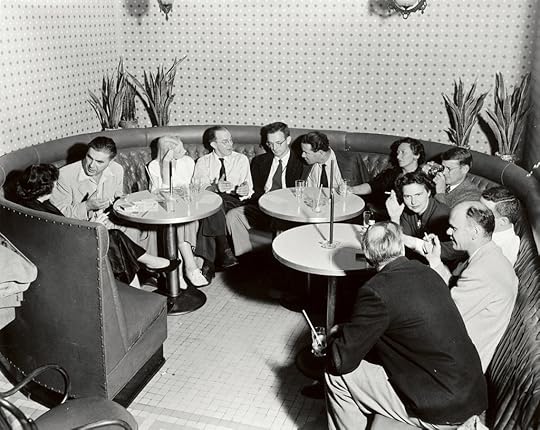 Robert C. Bishop, Bar in the Hotel Jerome, Aspen Conference, 1951
Robert C. Bishop, Bar in the Hotel Jerome, Aspen Conference, 1951Seated left to right: unidentified woman, Victor Babin (musician), Aline Porter, Will Connell, Wayne Miller, Ferenc Berko, Vitya Vronsky (musician), Eliot Porter, Nancy Newhall, unidentified man, Beaumont Newhall, Minor White
Image courtesy Norma and Laura Bishop, and The Minor White Archive, Princeton University Art Museum
Diana C. Stoll: From today’s perspective, the world of photography in 1952 seems so appealingly finite and manageable. Who was reading Aperture in the beginning? For whom was it intended?
Peter C. Bunnell: In a way, Aperture was for a small niche. It was intended for those who were committed to serious photography.
After World War II, photography as an art was confronted with the new status of photojournalism—the residue of 1930s documentary work—as well as the rise of advertising and magazine photography. Aperture was essentially driven by the idea that there must be some way to reposition a kind of serious photography, and that notion drew together the group of people who founded the magazine.
Aperture grew out of a 1951 conference on photography that was held at the Aspen Institute. A number of people had been invited to the conference who could address the reality of the field. If you look at the seminar titles, you get an idea of what some of the concerns were: “Evolution of a New Photographic Vision,” “Photography and Civilization,” “Picture Language and the Magazine,” “Photography in Advertising and Promotion,” “Photography and Painting,” “Objectives for Photography,” “Creative Directions in Color Photography.”
There was a subgroup at the gathering, which included Beaumont and Nancy Newhall, Minor White, Frederick Sommer, Ansel Adams, and Dorothea Lange. Aperture literally started with attendees of that Aspen conference, who after the meeting received letters saying: “This magazine has now been born. Here we go.”
To get it moving, Ansel reached out to people he knew, people like photography patron David McAlpin, for instance, and writer and editor Dorothy Norman, who had been Stieglitz’s sponsor. And there were other bits of help along the way. Jacob Deschin announced the first issue of the magazine in the New York Times [March 16, 1952] and gave the address for subscriptions. So progressively, mostly by word of mouth, it began to reach people. Including faculty and students of universities—like me.
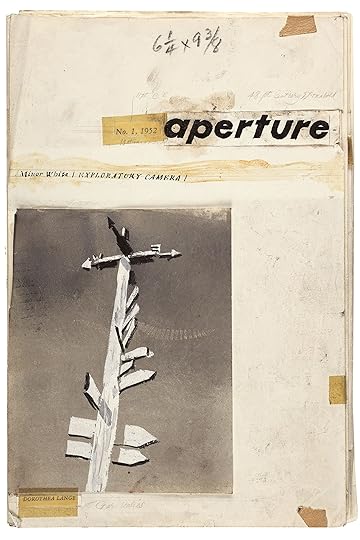
Maquette and final edition of Aperture issue 1, 1952, featuring an untitled photograph by Dorothea Lange
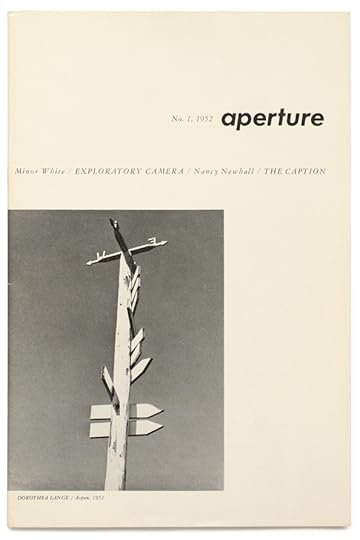
Stoll: What led you to photography?
Bunnell: When I was young, my initial idea was to be a fashion or magazine-illustration photographer. I thought that’s where the glamour was. My father, who was a mechanical engineer, wanted me to be an engineer, but I didn’t want to do that. As a teenager, I bought my first camera, an Argus C3 (which I later learned was the first camera Minor bought, in 1937). I learned how to develop and print, and I realized that I could make money photographing couples at dances and things like that. So I set up a little makeshift studio, and started selling 8-by-10 prints—and it kept getting me further and further from having to be an engineer.
I went to the Rochester Institute of Technology—R.I.T.—to study. R.I.T. was one of the few places to go for photography in 1954 or 1955; it had just begun a four-year program for photography. Minor had been brought in as added faculty when they expanded from a two-year program. He was first hired to teach photojournalism.
Stoll: But he wasn’t a photojournalist.
Bunnell: Right, he was not a photojournalist, but the idea was: if you know anything about photography, you can do it. You just put it in Life magazine! R.I.T.’s photography program was run like a trade school. For the first two years you studied physics, sensitometry, photochemistry; then maybe you could take a few pictures, but not many, because you were always busy in a lab someplace.
Then, all of a sudden, there was Minor. He taught a sophomore course (which derived from his curriculum at the California School of Fine Arts [C.S.F.A.], where he had taught previously) called “Visual Communication.” It was a whole new approach. We cut out pictures and glued them together to make multiple images. We did everything in that class—including learning how to “read” photographs. It was very eye opening.
Before the Thanksgiving break of 1956, Minor said to the students: “I’m having people over on Saturday evening; those of you who are not going home are all welcome.” I wasn’t going home (remember, I was trying to avoid my father), so a friend and I decided to go to Minor’s apartment. He had cooked a turkey—but I think only for about an hour, so it was practically bleeding! There were some other students, and Walter Chappell was there . . . and then in walked Beaumont and Nancy Newhall. We had a wonderful talk, and it was at that point that Beaumont asked if I might be interested in working with Nancy and him at the Eastman House during the summer. “But I don’t have any money,” he said. “You’ll have to find some way to deal with that.” And so I did it.
 Minor White in his Jackson Street studio-loft in San Francisco, ca. 1951
Minor White in his Jackson Street studio-loft in San Francisco, ca. 1951Image courtesy Minor White Archive, Princeton University Art Museum
Stoll: What did you do for them?
Bunnell: One summer I organized and cataloged the entire collection of Eadweard Muybridge’s motion studies and another I assisted Nancy Newhall with the research and editing of Edward Weston’s Daybooks. One year the Newhalls were putting together the Masters of Photography book for the publisher George Braziller. They would write an essay on a photographer, and then they would hand it to me and say: “Go pick out some prints to illustrate this.” So I would go and make some choices, and then they would look at them. “Why did you choose that one? That doesn’t have anything to do with the essay.” Then they’d say: “Get out such-and-such a portrait of Sir John Herschel.” So I would, and of course it was then obvious that that was the one that should be used.
Stoll: Were they always in accord with one another?
Bunnell: No. Nancy had a mind of her own. In fact, I’d say, if anything, Beaumont deferred to her. But Beaumont then ran the show at the Eastman House. They were building the collection. He had been the curator of the museum since 1948, and became the director in 1958.
Stoll: You mentioned that R.I.T. was one of the only places to study photography at the time. What other programs at universities existed in those years?
Bunnell: Well, things were just starting out. Among the first were programs at Ohio University, Indiana University, and the University of Minnesota. There was of course already the Institute of Design in Chicago, where you had Harry Callahan and Aaron Siskind, and László Moholy-Nagy’s legacy, and the C.S.F.A., where Minor and Ansel founded the program. And there was the beginning of a coterie of students who were studying photography elsewhere as well, including on the graduate level.
Stoll: And, getting back to Aperture’s early audience, presumably that’s where some of the magazine’s subscribers came from, the students and faculty of those programs?
Bunell: Yes. The original subscription price was $4.50—today it sounds ridiculous! That was minimal, even for then. Still, I suspect that faculty would subscribe and then hand it around, and then, as the students began to make their own way, they subscribed.
Aperture matured slowly in terms of numbers of readers. In only a few years they were sending out notices crying: “Help! We’re running out of money—please come on board.” 1954 was a crisis year. Certain people did step in to help, and in 1953 the Polaroid corporation began to run a discreet ad, which really saved the magazine from collapse. But clearly, it was not a financial success.
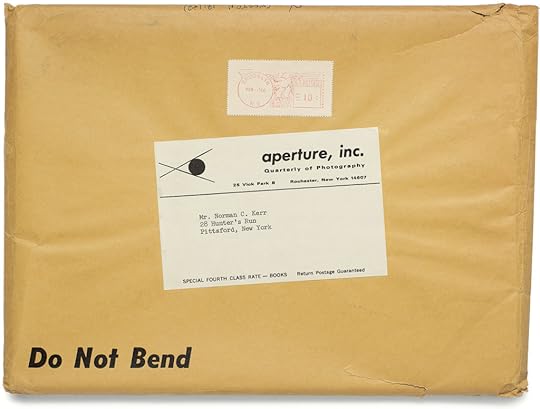 Mailing envelope, Aperture vol. 12, nos. 1 and 2, sent from Rochester, New York, 1966
Mailing envelope, Aperture vol. 12, nos. 1 and 2, sent from Rochester, New York, 1966Stoll: How did the magazine function logistically—I know it was a very small team of people that ran it.
Bunnell: The magazine’s staff was minimal, to say the least. At that point it was edited by Minor in Rochester and printed by Lawton Kennedy in California, and the finished issues were then crated and shipped to Rochester. When I began working with Minor in 1955, I was the subscriptions secretary—I typed every mailing label (actually, I got pretty good at it). I did that for about three years. We had to put each issue in an envelope with postage stamps and these hand-typed labels. I would say that at the height of my years with Aperture it got up to maybe a thousand subscribers—but usually it ran more like five hundred people.
Stoll: There’s a sense that the circle of interest was so concise in those years that everyone reading the magazine must have known one another. There were also a few photography galleries in New York—Helen Gee’s Limelight in the 1950s and later on Light Gallery and Lee Witkin’s space—they must have played into the network of this community of readers, too. Anyone visiting them might also have had an interest in Aperture. What are your memories of those spaces?
Bunnell: I used to go to the Limelight with Minor. We would drive down from Rochester to the city and start at MoMA, then take the E train to Sheridan Square, where the Limelight was. The gallery opened in 1954 and closed seven years later, in 1961. It was a coffeehouse as well as an exhibition space, but it was the only gallery you went to for photography at the time.
In the ’60s a few other little spaces opened up. But really the key players—which had the idea that photographs were important (and for sale!)—were Lee Witkin starting out (his gallery opened in 1969), and Light Gallery (which was founded in 1971). Earlier on, Julien Levy (whose gallery opened in 1931 and ran through the 1940s) in the first few years showed almost exclusively photography. There was also a place called the Downtown Gallery, which as I recall was located in someone’s apartment.
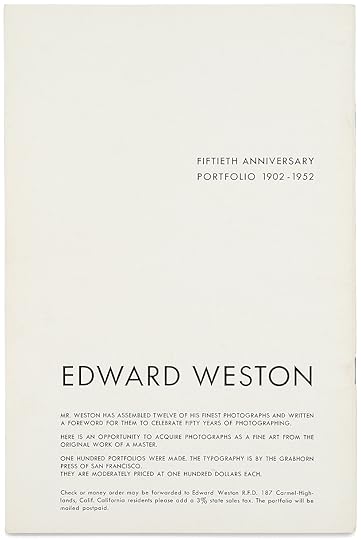 Advertisement for Edward Weston’s fiftieth-anniversary portfolio, Aperture issue 2, back cover, 1952
Advertisement for Edward Weston’s fiftieth-anniversary portfolio, Aperture issue 2, back cover, 1952Stoll: But the real, explosive success of photography would come a few years later.
Bunnell: Yes. And it was encouraged by Aperture in the sense that the magazine was where the list of many of the major photographers came from, more or less. Also, the great masters, notably Edward and Brett Weston and Ansel, were selling their photographs in portfolio form through the pages of Aperture. It was not a blockbuster situation—the Weston fiftieth-anniversary portfolio was advertised in Aperture for sale, and I think they sold only six.
But before its success in the market, this type of photography was really a kind of mission, a calling. It was almost a messianic thing. We believed in it, although it was not taken seriously by others, and it was economically overwhelmed by other kinds of photography. The idea that you would have a forum to show serious photographic work was almost unimaginable. I mean, it was Eastman House or the Museum of Modern Art, and that was it. (And at MoMA—until the 1960s, when they built an addition—the photo galleries were in the basement, outside the lavatories and the entrance to the museum’s cinema.)
So by necessity every avenue that Aperture could pursue, it did—they believed in photography. There is no doubt in my mind that the founders saw this as the new Camera Work.
Stoll: Obviously there were economic differences, and the era was not the same, but what were the philosophical similarities and differences between Camera Work and Aperture?
Bunnell: In some respects, there were very few differences. At the beginning of Camera Work, Alfred Stieglitz was propounding a new view of photography, which we now put under the heading “Pictorialism” (which of course had its variations). Over the life of the magazine his concept of contemporary photography, as with art in general, changed and the content of the publication was altered accordingly until, by the 49/50th issue of Camera Work, devoted to Paul Strand, one was very far from the Gertrude Käsebier featured in the first issue.
Similarly, Aperture was propounding a new kind of photography—a new vision of photography. It wasn’t Pictorialism, of course, but it was a new art for a different time; interestingly, however, it was based in part on that of Paul Strand.
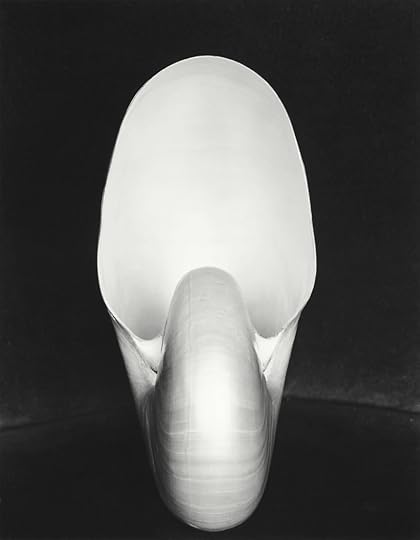 Edward Weston, Shell, 1927, from The Flame of Recognition (Aperture, 1965; reissued in 2015)
Edward Weston, Shell, 1927, from The Flame of Recognition (Aperture, 1965; reissued in 2015)Courtesy 1981 Center for Creative Photography, Arizona Board of Regents
Stoll: And what about the writing?
Bunnell: I’d say there might have been even more writing in Camera Work than in Aperture. Stieglitz had a wide circle of literary acquaintances, who all wrote for the journal—from people like Sadakichi Hartmann to Joseph T. Keiley, John Kerfoot, Charles H. Caffin, and Dallett Fuguet. And because Pictorialism had a connection to the Salon movement, which was very active in those days, Camera Work had a lot of reviews. The publication also chronicled the Photo-Secession gallery exhibitions, and those elsewhere; this continued right to the end, in 1917.
Things were quite different in Aperture’s early years. Really, the opportunities for reviewing were fewer from the 1950s and ’60s until the beginning of the galleries era.
Stoll: I know that photographers generally weren’t paid for their contributions to Aperture. Were commissioned writers paid?
Bunnell: I don’t think anyone was paid. (Well, I was paid, but minimally.) Actually, if I remember right, there was one announcement that went out with the magazine and said straight out—I’m paraphrasing: “This is a work of love, and no one gets paid for content.” By emphasizing production costs, Minor was trying to justify the subscription expense, explaining to subscribers where their money was going.
 Minor White editing photographs for the Celebrations exhibition and Aperture vol. 18, no. 2, M.I.T. Warehouse, 1972
Minor White editing photographs for the Celebrations exhibition and Aperture vol. 18, no. 2, M.I.T. Warehouse, 1972Stoll: The subscription money went straight to production?
Bunnell: Yes: there was no other money available. I can remember even rationing long-distance calls. I mean, Minor didn’t get on a phone and call somebody and say: “Where’s your goddamn manuscript?” He wrote a letter and used a three-cent stamp, because he didn’t have the money to make a phone call!
Minor always lived very modestly himself. In Rochester he had an apartment above a hardware store at 72 North Union Street. One bedroom was made into the Aperture office, and the magazine was assembled in the large center living area. His darkroom was in the basement. Later on, when he left R.I.T. and went to the Massachusetts Institute of Technology, he received a significant salary, so much that he literally didn’t know what to do with it. And on top of that, he had to perform socially. I remember going with him to Brooks Brothers to buy him a blue suit, so that he could go to events that he had to attend at M.I.T. I think the second time he wore it he spilled a martini all down the front, which stained it of course. (If you look carefully at photographs of him at the time, you can see this funny little stain.)
So Aperture operated on practically nothing in its early days—about five thousand dollars a year. At one point Minor wrote an editorial note saying: “We have simply run out of money for half-tones, for engravings, and so therefore this issue is all text.” Despite the simplicity of the first issues, very progressively, the magazine was seen as a quality-reproduction publication. And that is an aspect of Aperture that has been retained to today.
This interview is excerpted from Aperture Magazine Anthology: The Minor White Years, 1952–1976 (Aperture, 2012).
Diana C. Stoll is a writer and editor based in Asheville, North Carolina. She was senior editor of Aperture magazine from 2006 to 2013.
September 14, 2021
The Women Who Reshaped Modern Photography
At the end of Henrik Ibsen’s 1879 play A Doll’s House, Nora slams the door on domesticity, tired of how her whole life she’s been nothing but a “doll child,” first to her father, then to her husband. Performed in England in 1889, the play exemplified the emerging “New Woman” that would be named by Irish writer Sarah Grand a few years later. Audiences at the time were scandalized that, in search of greater freedom, Nora would leave her husband—even her children!—in order to do what, exactly? And to what end?
 Unknown photographer, Tsuneko Sasamoto, Tokyo, 1940
Unknown photographer, Tsuneko Sasamoto, Tokyo, 1940Courtesy Tsuneko Sasamoto/Japan Professional Photographers Society
The New Woman may be most familiar as an aesthetic: sporting bloomers (later trousers) and cropped hair, “rational dress” and androgyny lite, she stands by her bicycle with a cigarette, exuding freedom and sexual liberation. Facing obstacles different from her working-class (who were already laboring outside the home) and aristocratic (who had more freedom generally) peers, the bourgeois nineteenth-century New Woman strove to free herself from the confines of the Victorian “angel in the house” ideal that emphasized a separation between public and private spaces, itself a function of the developing middle class. Fundamentally born of increased rights and opportunities for bourgeois European women, the New Woman (or nouvelle femme, neue Frau, modan gāru, xin nüxing, al-mar ‘a al-jadida) would develop into the twentieth century as women around the world sought new freedoms.
The New Woman Behind the Camera—organized by National Gallery of Art (Washington, DC) curator Andrea Nelson, and now on view at New York’s Metropolitan Museum of Art—uses this first-wave feminist framework to revivify the contributions, a few decades later, of women photographers to early twentieth-century modernism. But picturing her is only a small part of the show’s purpose—the New Woman is, after all, behind the camera. The exhibition, as clarified by the catalogue, argues that New Womanhood arose in conjunction with major developments in photography. How this historical marriage offered alternatives to women at the time animates the ample array of images on view at the Met, making a case for the overlooked significance of these photographers and their innovative work.
 Dorothea Lange, Japanese-American owned grocery store, Oakland, California, March 1942
Dorothea Lange, Japanese-American owned grocery store, Oakland, California, March 1942National Gallery of Art, Washington, DC
More study than survey, the exhibition brings together a dizzying range of photos taken between the 1920s and the 1950s by 120 international women photographers (the wall text notes, “the designation ‘woman photographer’ is imperfect [as is the adjective ‘female’], yet it remains a useful framework for analysis”). Remarkably varied subjects and approaches are organized into imperfectly general categories, no doubt needed to mitigate audience overwhelm, but not fully up to the task: The City, Avant-Garde Experimentation, Ethnographic Approaches, Fashion and Advertising, Social Documentary, Modern Bodies, and Reportage—each one granted a room of its own.
The central revelation of the show is the fact that the early twentieth-century New Woman found a natural home in commercial photography. As critiques of gender norms collided with the rise of the Picture Press and the two world wars pushed women further into the workforce, fashion and portrait photography were deemed, to varying cultural degrees, socially acceptable pursuits, and more women experienced increased access to the public sphere. The importance of commercial photography, though represented in number on the walls of the Met, really clarified itself only with the catalogue texts, which I found to be integral to understanding the interplay between the emerging New Woman and the developing medium.
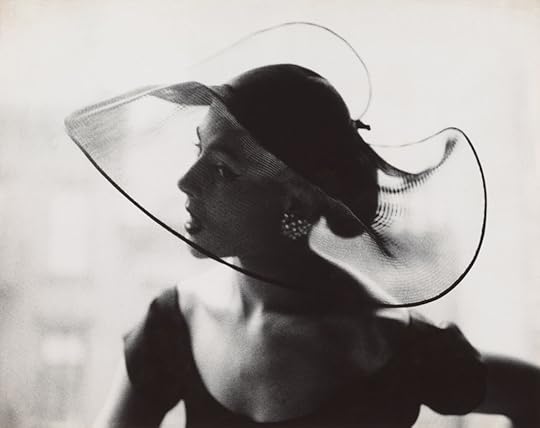 Lillian Bassman, Translucent Hat, ca. 1950
Lillian Bassman, Translucent Hat, ca. 1950 National Gallery of Art, Washington, DC
Advances in technology made cameras more affordable, easy to use, and portable, multiplying the number of studios, camera clubs, and amateur societies. Women have worked in studios since the camera’s invention in the 1830s, but professional training for women expanded into the early twentieth century, especially in Germany and Austria. Opportunities were influenced by class and culture, and those without means or access pursued training in studios, crafts schools, or vocational programs, or were self-taught.
Weimar-era Berlin, the fashion capital of its time, saw women forming 36 percent of the workforce by the mid-1920s as the ready-to-wear Konfektion clothing industry boomed—an early iteration of fast fashion, much of it Jewish-owned, making affordable France’s haute couture—and along with it, the largest and most modern print media in Europe (both industries were violently “Aryanized” with the Nazis’ rise to power in 1933). Fashion photography allowed many women access to public life, and in some cases, economic independence and professional success; in 1931 Berlin, women ran 130 of the 430 photography studios (the subversive advertisements and surrealist collages of Grete Stern and Ellen Auerbach’s ringl + pit studio are particularly witty).
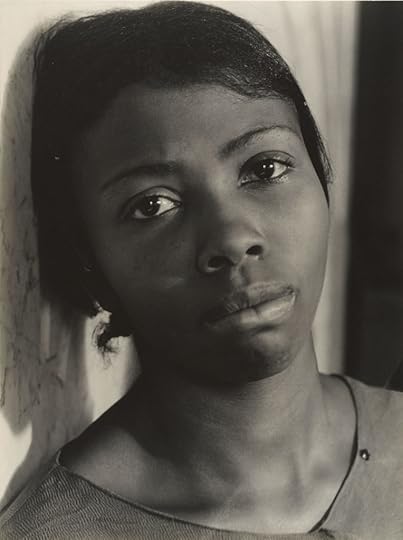 Consuelo Kanaga, Annie Mae Merriweather, 1935
Consuelo Kanaga, Annie Mae Merriweather, 1935© The Metropolitan Museum of Art/Art Resource, NY
Through studio work, women were able to live out their New Womanhood while also experimenting with expressing it. During the 1930s and 1940s, there were a number of women-only portrait studios in Iraq, Jordan, India, Korea, and Japan. In Palestine, Karimeh Abbud advertised herself as a “Lady-Photographer,” helpfully bringing her own makeshift studio into private homes. Armenian Maryam Şahinyan ran a studio for almost fifty years in Istanbul; among her 200,000 images of mostly family portraits and passport pictures are striking photographs of people expressing nonnormative gender. With the post-Reconstruction influence of the New Negro Movement, Black American portraiture worked to counter the media’s racist imagery with photos asserting humanity and respectability. Black women photographers faced additional barriers to entry, and “the extent of their . . . contributions to the field has yet to be properly established,” writes Nelson. In one remarkable example, Florestine Perrault Collins of New Orleans, who worked almost exclusively with Black and Creole clients, pictures her friend Mae Fuller Keller looking casually glamorous—from her pose and expression to her bobbed hair and ruffled dress, Keller is all modern mettle.
For the most part, history has discounted the fruits of this fascinating feedback loop between photography and New Womanhood. Commercial work was not seen as serious art, but instead considered technical, market-driven, clichéd. (Photographs of children, an especially marketable and conventional subject for women, have largely been written off by history, despite the fact, as Elizabeth Cronin argues in the catalogue, that some women photographers made innovative and radical artistic choices within socially acceptable constraints.) Fashion photography was often dismissed as frivolous. Here’s Siegfried Kracauer, quoted in the catalogue, on the mass ornament and popular media’s “blizzard of images”: “The new fashions also must be disseminated, or else in the summer the beautiful girls will not know who they are.”
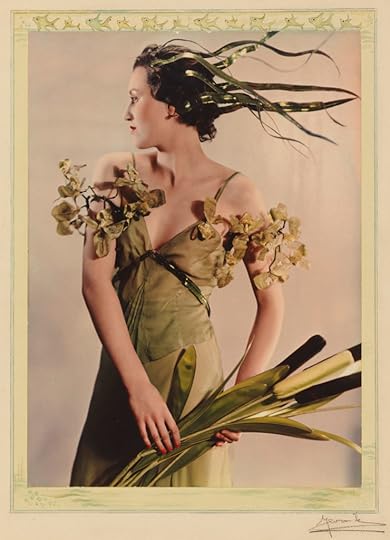 Yevonde Cumbers Middleton, Lady Bridget Poulett as ‘Arethusa,’ 1935
Yevonde Cumbers Middleton, Lady Bridget Poulett as ‘Arethusa,’ 1935National Portrait Gallery, London
Behind Kracauer’s acerbity is the accidental observation that these images really did offer women new ways of seeing and understanding themselves—photographs of the New Woman, but also the bylines of women photographers. From 1931 to 1937, Shanghai’s Linglong magazine advertised modern images of the Chinese New Woman, including those of women as hobbyist photographers on the model of the Kodak Girl. Margaret Bourke-White was a Life celebrity. To be sure, not all commercial photographs by women were interesting, artful, or radical. But one can imagine the refractive power of seeing, in 1921, the portrait of artist Mariette Pachhofer in hat, tie, and lace-up riding boots—a paragon of New Woman chic—made by Madame d’Ora (Dora Kallmus), the most established international fashion photographer of the mid-1920s to late 1930s.
D’Ora portrayed women, she said, “as they wished to be seen.” It’s rarely that simple, but as advertising was wholly changed by the advent of photography, experimentation there actually could blur the lines between the commercial and artistic, the realistic and abstract. The New Vision aimed to reflect the reality of the everyday with its geometry, photomontage, and abstraction, spreading parallel to photographic surrealism, in which women participated as much more than merely muses. Photomontages by Hannah Höch, Marianne Brandt, Toshiko Okanoue, and Grete Stern picture a fragmented and frenetic modernity, critiquing gender norms, inequality, and war. Yvonne Chevalier’s Nu (Nude) (1929) is a study in abstracted and ungendered sensuality. Ergy Landau’s 1932 self-portrait shows the photographer in full dark dress positioning her body and camera to capture a serpentine nude on the floor, a twist on the odalisque trope.
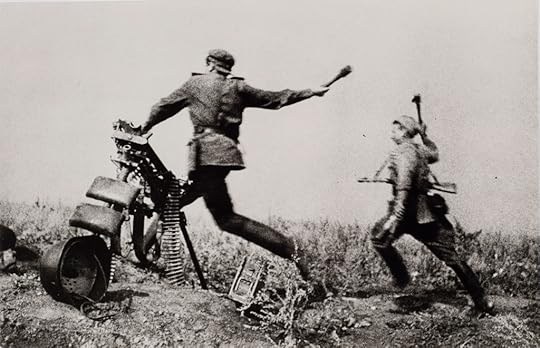 Galina Sanko, During an Attack, 1943
Galina Sanko, During an Attack, 1943Robert Koch Gallery
In this way, the relation between women and photography unfolds in The New Woman Behind the Camera not so much as linear history, but as a circuitous process of seeing and being seen; picturing, being pictured, and picturing anew. In each room and essay, she threatens to burst the frame, resisting containment by any one category, theme, or definition. Nelson and the other essayists flag areas of study they hope will be further explored; this would be welcome, particularly from parts of the world less represented here. The exhibition gives the sense of a bursting, righteous, meticulous, and sometimes messy beginning.
To take down the “great man” theory of photography is not simply to celebrate great women, but to understand photography as a collective and collaborative endeavor.
Between two world wars, global economic depression, movements for decolonization, and the rise of fascism, communism, and the modern city, reportage and social documentary were popular genres for capturing a time distinct from, but not wholly unlike, our own. Fantastic photographs by famous names like Bourke-White, Helen Levitt, Berenice Abbott, and Dorothea Lange—including the latter’s powerful accounts of Japanese-American internment camps—are joined by many less widely known, such as one of India’s first female photojournalists, Homai Vyarawalla, whose kinetic, peopled photos document the beginning of Indian independence. Tsuneko Sasamoto’s Tokyo street photos and Niu Weiyu’s images of newly communist China are not to be missed. (Mao Zedong floating in the Yangtze River, taken in 1956 by Hou Bo, is at once humorous, melancholy, and eerie.)
Some careers were curtailed by marriage and children, others by exile or war. In Lola Álvarez Bravo’s En su propia cárcel (In Her Own Prison) (1950), a woman leans out a window in post-revolutionary Mexico, caged—behind a grid of shadow and light—by domesticity, and perhaps more. As European and American women made pioneering ethnographic portraits of other cultures—notably in Africa—they were not exempt from photographic colonialism. A small number of women, like Lee Miller and Galina Sanko, took combat photographs during World War II, while others documented its ravaging effects. But the majority of women involved in photography were not famous photographers or luminaries. Following the explosion of mass media with rotogravure printing, women participated at every level in the development of photography and its dissemination; Nelson notes that women most often worked professionally as print finishers and retouchers.
 Vera Gabrielová, Untitled (Spoons), 1935–36
Vera Gabrielová, Untitled (Spoons), 1935–36Courtesy Ellen and Robert Grimes
Celebrating the men behind the magazines—Henry Luce of Life, Jean Prouvost of France-Soir and Paris Match—as single-handedly ushering in a new age of photography discredits “the elaborate teams of editors, art directors, researchers, reporters, and photographers—many of them women—who were the driving creative force behind this international phenomenon,” writes Kristen Gresh in the catalogue. Nadya Bair, in her recent book The Decisive Network: Magnum Photos and the Postwar Image Market (2020), similarly argues that integral to the agency’s lauded photographers and the postwar visual culture they created was the collaboration of sales agents, writers, editors, publishers, and spouses.
To take down the “great man” theory of photography, then, is not simply to celebrate great women, but to understand photography, and media more generally, as a collective and collaborative endeavor. The aim of The New Woman Behind the Camera, explain Nelson and Mia Fineman (who installed the show at the Met) in their preface, is not only “to insert neglected, forgotten, or marginal figures into existing art-historical narratives,” but “to complicate and enrich our understanding of modernity” itself.
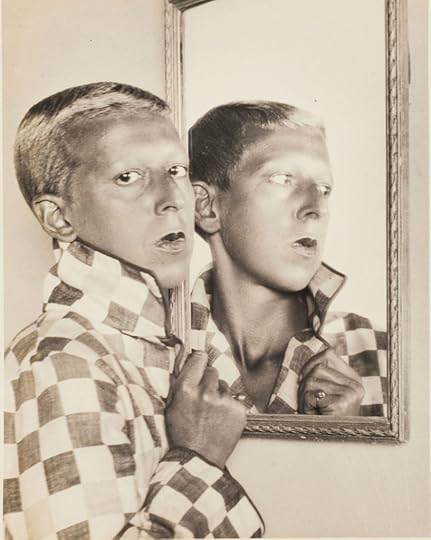 Claude Cahun, Self-Portrait, ca. 1927
Claude Cahun, Self-Portrait, ca. 1927Wilson Centre for Photography
Self-portraits, seen throughout the show, are collected at the back of the catalogue—doubly powerful in their use of reflection and multiple exposure, their visualization of the camera as both a tool for the New Woman’s self-determination and her self-expression. The shadow of Lotte Stam-Beese in profile with her camera appears against a sun-soaked door. Annemarie Heinrich and her sister Ursula are ecstatically captured hands outstretched and laughing in a reflective orb. In each of these images—even the more traditional Bourke-White echoing her tripod’s stance in slacks, gesturing toward her camera as if toward a loved one—we see the New Woman picturing herself as she wished to be seen, both behind and before the camera, powerfully training and framed by her own lens.
The New Woman Behind the Camera is on view at the Metropolitan Museum of Art, New York, through October 3, 2021.
Aperture’s 2021 Gala Celebrates the Reach of Photography Today
This year, Aperture’s annual gala celebrates the range of its publishing program with three honorees: artists Sara Cwynar and Graciela Iturbide, and esteemed collector Dr. Kenneth Montague. Aperture’s Executive Director, Sarah Meister, notes “the breadth of their practices reflect distinct and essential approaches to the medium, and point to Aperture’s vital role in adding context and nuance to these achievements.”
The two-day celebration opens with an in-person gathering on October 19 at Selina in Manhattan, featuring entertainment and a preview of special prints and experiences as part of our annual fundraising auction. This is followed by a virtual celebration on October 20, featuring honoree tributes by Pablo Ortiz Monasterio, Legacy Russell, Jamel Shabazz, and more. Leading up to the gala, a special photography auction in partnership with Artsy will open on October 8.
The gala provides critical sustaining support for Aperture’s publications, educational initiatives, exhibitions, and public programming. It aims to celebrate Aperture’s community of inspiration and almost seventy-year history of publishing groundbreaking photography, fostering the development and appreciation of the medium and its practitioners.
Below, read more about this year’s honorees and see here for information on how to register for the 2021 Aperture Gala.
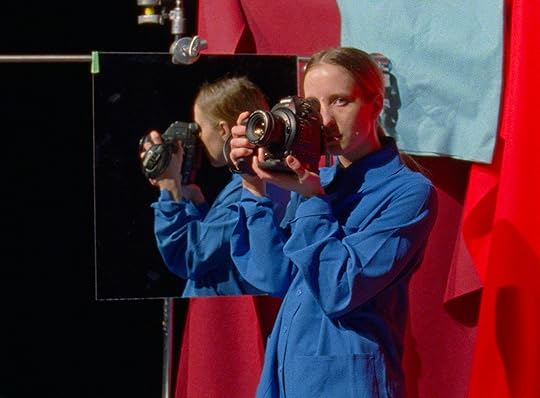 Self portrait by Sara Cwynar
Self portrait by Sara CwynarCourtesy the artist
Sara Cwynar
Aperture honors Sara Cwynar for her research-driven and visually complex photographs that investigate color and consumer culture on the occasion of her first monograph, Sara Cwynar: Glass Life (Aperture, 2021). Cwynar’s images constitute the hallmark of contemporary post–Pictures Generation work—in which photography is pursued to relation to film, sculpture, digital culture, and the cultural and technological history of image-making. Her previous artist books include Kitsch Encyclopedia (2014) and Pictures of Pictures (2014), and her film Red Film (2018) was featured in the 2018 São Paulo Biennial and is in the permanent collection of the Museum of Modern Art, New York.
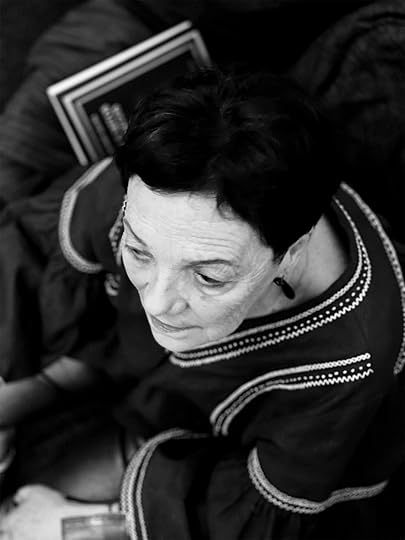 Graciela Iturbide photographed by Mario Bellatin
Graciela Iturbide photographed by Mario BellatinCourtesy the artist
Graciela Iturbide
Recognized today as one of the greatest living photographers in Latin America, Graciela Iturbide envisions the rich cultural heritage and diversity of life in Mexico, particularly its Indigenous traditions. Known for her lyrical black-and-white photographs, Iturbide has transformed everyday life into poetic and powerful art for more than fifty years. Aperture honors Iturbide’s decades-long practice and inspiring work, including her upcoming title for Aperture’s Photography Workshop Series.
 Dr. Kenneth Montague photographed by Markian Lozowchuk
Dr. Kenneth Montague photographed by Markian LozowchukCourtesy the artist
Dr. Kenneth Montague
Dr. Kenneth Montague started the Wedge Collection in 1997 to acquire and exhibit art that engages multifaceted ideas of Black life through the lenses of community, identity, and power. Aperture honors Dr. Montague on the occasion of the release of As We Rise: Photography from the Black Atlantic, a forthcoming Aperture book presenting a compilation of photographs from the Wedge Collection. Featuring over one hundred works by Black artists from Canada, the Caribbean, Great Britain, and the United States, as well as throughout the African continent, the volume serves as a testament to the support provided to artists by collecting and amplifying their work.
The 2021 Aperture Gala takes place on October 19 and 20, 2021. See here for full program details and to register for the free virtual event.
September 9, 2021
Judith Joy Ross’s Timeless and Empathic Portraits
Judith Joy Ross wants to show me her garden. As she throws open the back door to her home in Bethlehem, Pennsylvania, a large brown rabbit flashes across the yard, a comet trail vanishing into a maze of plants vivid and green against the gray sky. Ross turns to me, her face bright with excitement, “Did you see that?” I am reminded of a story I had heard, how once, while driving in rural Pennsylvania, Ross had seen something in a kid’s face that caused her to pull the car over abruptly, drag her 8-by-10 camera out of the car, and call after two boys, aged twelve or so. Within moments, as Ross disappeared under the cloth and the boys began to arrange themselves before her lens, the alchemy of their connection became palpable.
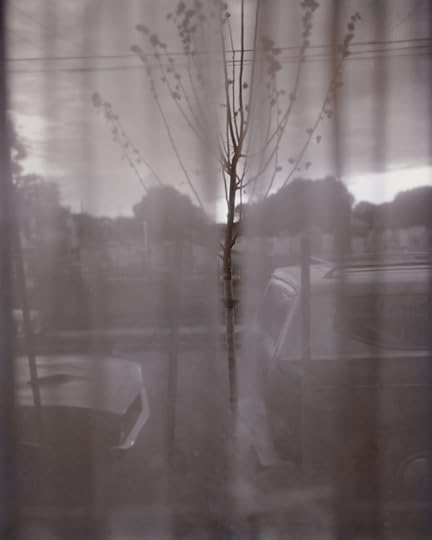 Judith Joy Ross, 305 North Tenth Street, Allentown, Pennsylvania, 1983
Judith Joy Ross, 305 North Tenth Street, Allentown, Pennsylvania, 1983Those particular photographs did not materialize—there was a problem with the film that day—but the Judith Joy Ross pictures that do survive are the representation of thousands of such lightning encounters dating back to the late 1970s and first widely introduced at the 1985 New Photography exhibition at the Museum of Modern Art in New York. Ross is a master of the formal portrait, exquisitely executed with astonishing emotional clarity, as if she could see straight into the innermost lives of the earnest schoolchildren and tormented teenagers, the ennobled gas station attendants and car rental reps, along with veterans, senators, mourners, and protesters, most of them in the United States, most of them not far from Hazleton, Pennsylvania, the former coal-mining town where she was born and raised. These people form her photographic universe. “She has this extraordinary antenna,” former MoMA curator Susan Kismaric, who has worked closely with Ross over the years, told me recently. Kismaric was along for the ride when Ross was photographing in Minersville. “Judith never projects, she never condescends or judges, but she intuits.”
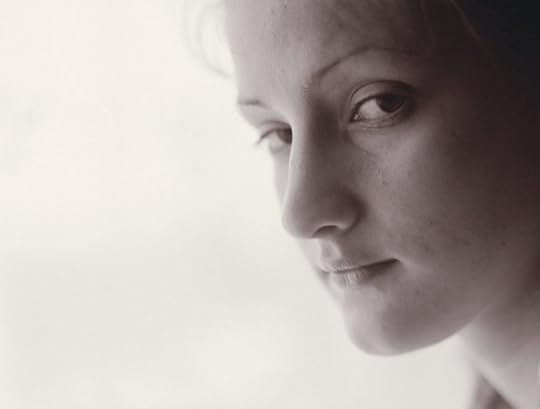 Judith Joy Ross, Celia, 1980
Judith Joy Ross, Celia, 1980In person, Ross is gentle, emphatically honest, devastatingly funny, frequently cursing—all at once. White blunt-cut bangs frame her face; she wears glasses in an outdated prescription. She rarely is idle for long, but when a thought overtakes her, she is apt to rest her entire head in her hands to fully consider it. She greets me on the porch of her yellow house, which, much to her dismay, overlooks construction that will soon obscure her view of Bethlehem, where she has lived for more than half her life. Inside is a home wholly devoted to photography, from the darkroom in the basement to the archives in the attic. “I long for two thousand square feet to store all this shit,” she says. There is a large computer monitor in the dining room; its table holds recent contact prints. For her major retrospective, set to open in September at Fundación Mapfre, in Madrid, and travel through Europe, custom photographic paper was made to replace the now discontinued printing-out-paper Ross relied on for years.
In the early 1980s, when photographers could simply show up in person on an appointed day at MoMA and drop off their portfolios for review, Ross was called in to speak with John Szarkowski, the photography department’s director, who, looking at her first major series, Eurana Park (1982), asked if she knew the pictures of the German photographer August Sander. Ross lied and said she didn’t. “I was like Judas denying Christ,” she says. “I didn’t want him to think I was cheating.” Szarkowski, who bought two of the pictures, offered reassurance: “It’s okay, Judith. It’s called tradition to be influenced by another’s work.” She had, in fact, studied Sander’s pictures closely—how he photographed straightforwardly, centering the person in the frame. Sander’s monumental series Menschen des 20 Jahrhunderts (People of the 20th Century), begun in the 1920s and proceeding for decades, identified and grouped subjects by occupation and social class. Ross isn’t nearly as taxonomic; she is guided by a rapt, intense, wholehearted belief in the individual. (Ross disputes that Sander categorized people.) Her idiosyncratic printing practice—contact prints on printing-out-paper that are then toned with gold— enhances the fundamental uniqueness of the individuals she encounters. “No two prints by Judith are the same,” says Joshua Chuang, who is curating Ross’s retrospective and editing the accompanying catalogue. “Her way of experiencing humanity is through photography.”
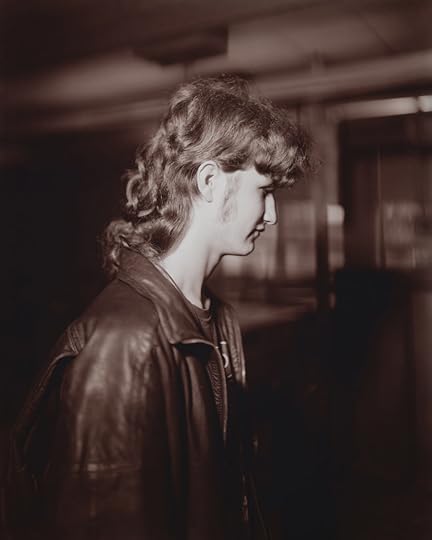 Judith Joy Ross, Timmy Wright, Shop Class, Hazleton High School, 1992
Judith Joy Ross, Timmy Wright, Shop Class, Hazleton High School, 1992 Judith Joy Ross, Untitled, Eurana Park, Weatherly, Pennsylvania, 1982
Judith Joy Ross, Untitled, Eurana Park, Weatherly, Pennsylvania, 1982When she was coming up, Ross entered a world dominated by the iconographic portraits of Richard Avedon, Irving Penn, and Diane Arbus, pictures often first published in magazines, where they had to leap off the page. Ross’s work, in a range of subtler tones, operates differently. Her contact prints are almost never bigger than the 8-by-10 dimensions of the negative. To enlarge them, she believes, could be “exploitive.” Of the prints’ scale and intimacy, Ross says, “They are asking you to come closer, and say hi.”
“Like Diane Arbus and like Lisette Model, Arbus’s teacher, she is working with the idea of the self, the tension between who one is and who one projects to the world,” Kismaric explains. “With Arbus, one still sees something of that struggle; in Judith’s pictures, outside the cosmopolitan world, it feels as though they’re working against futures that were prescribed for them. The questions become more complicated.”
Just as complicated is the question of why a photographer so revered by other photographers remains, to an extent, under the radar. The photographer An-My Lê once recalled how, when Ross visited her in New York, she’d play a game of guessing who on the subway Ross would choose to photograph; the fact that she was always wrong cemented Lê’s awareness of Ross’s empathic intuition. “Her work is beautiful in its transparency,” Robert Adams writes in his book Why People Photograph—it’s “a record of compassion.” Gregory Halpern, a photographer who teaches at the Rochester Institute of Technology, has called her “the greatest portrait photographer to have ever worked in the medium.” The photographer Paul Graham, who has taught with Ross at Yale, fell first for her Vietnam Veterans Memorial pictures. “It’s one of the dirty little secrets of photography,” he told me recently. “People act like they want to photograph rocks and houses and trees but what they really want is to have the gumption to photograph people the way Judith does.”
Ross’s pictures are holy in their awkwardness—the teen with the dark gothic bangs wielding a rake, the way the girls clasp their hands over their bathing suits.
Photobooks dominate Ross’s shelves along with images by friends, such as Chris Killip, who died in October 2020. “I can’t understand how his pictures can be so beautiful,” she exclaims. “Tiny little people shown this big, yet every one of them is seen as an individual! Such humanity. Oh, my God. He is missed.” Cabinets in nearly every room are filled with boxes of prints and negatives. To a visitor, the house can feel like the brain’s memory chambers. Ross claims her own memory is foggy, but whenever a gap emerges, she herds me upstairs to look through the cabinets of boxes of prints to supply the story.

Judith Joy Ross, Philadelphia, Pennsylvania, 1998
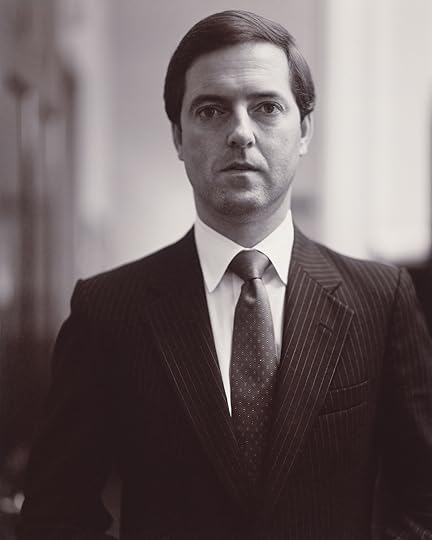
Judith Joy Ross, Congressman John P. Hiler, Republican, Indiana, 1987
Above her dresser, framed works by her heroes mingle with family pictures. “That’s our summer home, where my heart is,” she says, pointing at a photograph of a cabin in the borough of Weatherly, Pennsylvania, where Ross grew up daydreaming and playing with her brothers among the creatures in the woods. “That’s my mom, that’s my dad, that’s my Atget,” she says, pointing out a print of the Panthéon, a revered gift from her brother Edward. The influence of the French photographer is evident in a few of Ross’s early personal pictures: One of her mother, a piano teacher, shown in profile, “looking with some sadness at jewelry at the Met,” on a trip she and Ross had taken to New York. One of her father, reclining on a forest floor, dressed in a suit, appears romantic and elegiac. “Fucking suit and a tie in the woods!” Ross says, laughing. It could have been made after a day at the five-and-dime store he owned in Nanticoke, a former mining town where other relatives also had shops selling candy and secondhand books. “He used to let me help out, paint faces on the mannequins,” she recalls. “I’d put eyeliner on them; I made them even worse. But he never minded. He just wanted us nearby.”
Ross made her first photographs in the mid-1960s as a student at Moore College of Art and Design, in Philadelphia. At the IIT Institute of Design, in Chicago, where she earned an MA in photography in 1970, she felt disconnected from Aaron Siskind’s experimental-minded program. “I was lost,” she says. “Eventually, I didn’t go to class. Including the Literature of Alienation. I should have gotten at least a C because I never went. I mean, what’s wrong with these people!” The lost feeling lingered for a decade. Ross went to Bethlehem, where she taught at Moravian College, simultaneously giving herself the photography education she felt she never received in school, via Eastman Kodak materials and the exhibitions she’d see (Arbus and Bruce Davidson, among others) and books she’d buy (Sander, Atget, Lewis Hine) in New York, two hours away. Eventually, she began photographing again.
 Judith Joy Ross, Untitled, Eurana Park, Weatherly, Pennsylvania, 1982
Judith Joy Ross, Untitled, Eurana Park, Weatherly, Pennsylvania, 1982In 1982, the devastation she felt over her father’s death carried her back in time. The beloved summer cabin was lonesome in his absence. Ross took her recently purchased 8-by-10 view camera a few miles away, to a public swimming park in Weatherly. In her mind, the children and teenagers she met there at Eurana Park represented a time of innocence before the first experience of grief. The pictures are holy in their awkwardness—the teen with the dark gothic bangs wielding a rake, the way the girls clasp their hands over their bathing suits—barely visible surroundings briefly lifting them out of their lives. In some, droplets of water can still be seen on skin, evidence of how quickly Ross must have forged these connections.
“I photographed people from the get-go. Even though I didn’t know how to have them in my life. That’s probably why I’m good at it,” Ross says. “Something happens, I see them intensely, and we never see each other again. I know it’s just a photograph. I know I’m being delusional. But I like to think I’m capturing the real thing.”
“But if you didn’t think that it was the real thing in the moment, could you even make the picture?” I ask. Ross shakes her head emphatically, no.
Related Items
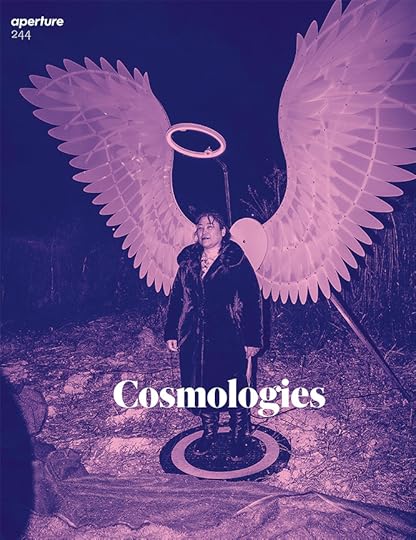
Aperture 244
Shop Now[image error]
Aperture Magazine Subscription
Shop Now[image error]Over the years, the arc of her work has expanded in scope to wider communities, public institutions, and national politics, projects for which Ross has sometimes earnestly sought the permission of mayors and civic organizations. But the true subject is both as simple and complicated as every human she meets. In 1983, thinking she would do a series about the United States and the Vietnam War, she traveled to Maya Lin’s granite memorial in Washington, D.C., and found herself drawn to solitary expressions of grief.
The distinctions between her projects became apparent in her printing techniques. “In Eurana Park, certain browns were happy,” Ross says. “When kids were pubescent they turned gray. For me, I didn’t get puberty. I wasn’t a happy camper with sexuality.” Tones for Ross exist on a psychological register, darkening or morphing over time. “Certainly Vietnam was gray. And the gray got so extreme. Pictures from Nanticoke, they might be an exquisite gray with a dash of purple in it that was melancholy. Or a brown shadow on a gray print. A gray print means something.”
In 1986, armed with a Guggenheim grant, one good suit, a makeshift shopping cart for her equipment, including a suspicious- looking box swathed in duct tape to hold her camera, and an inborn fear of authority figures, Ross set out for Capitol Hill—“gray with highlights and a hint of brown in the shadow.” She photographed Strom Thurmond “with his five-foot-tall shoulders and shrunken apple head, surrounded by his French furniture. . . . This awful racist person but I was seduced by his presence.” Her skill at creating instantaneous connections, and the magic ritual of bringing out the view camera, were crucial in these fifteen-minute appointments. In the faces of the members of Congress, humanized in Ross’s frame, it is possible to glimpse, briefly, an aspect of their private selves, not far removed from her young swimmers and workers back in Pennsylvania.
In the early 1990s, when money was tight, Ross began cleaning houses. “Does it look like I’d be a good maid?” she joked, waving at her stacks of archival boxes. “I carried superglue with me on the job; I broke everything.” It was in the midst of this time that the photographer John Gossage called to tell her she’d won a Charles Pratt Memorial Award of $25,000. First, she retorted, “How do I know you’re John Gossage?” and then she called the owners of the house she was supposed to clean that day to say she wasn’t coming. “I’m Cinderella! I just got a grant!”
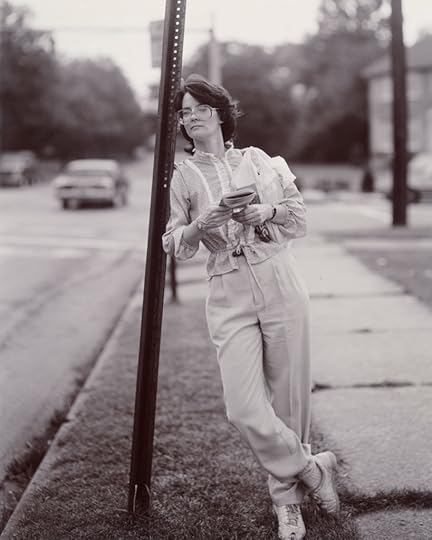 Judith Joy Ross, Bus stop, Bethlehem, Pennsylvania, 1989
Judith Joy Ross, Bus stop, Bethlehem, Pennsylvania, 1989From 1992 through 1994, she returned to the same public schools in Hazleton she’d daydreamed through while growing up. Again, the goal was idealistic. “I wanted people to pay their taxes. I wanted people to care about public education,” Ross says. “I certainly didn’t care about mine. I thought school sucked.” Ross’s Hazleton pictures are singular in their acknowledgment that school can indeed suck, and in their eerily personal portrayal of the vastness and discomfort and yearning and angst of adolescence— the pride of a perfectly brushed mullet or a cascade of sprayed hair. “These are their own selves,” she says. In a print displayed in her front room, a boy stares at the camera through glasses so thick you long to tell him they’ll be considered cool in twenty years. But here, he simply is a high schooler briefly showing his vulnerable self. Ross’s framing preserves this, acting as a protective shell.
Protest the War (2007), an unassuming little book published by Steidl and Pace/MacGill, her gallery at the time, is about the size of a trucker’s logbook or a horse-racing pamphlet. Ross, hoping the pictures could change people’s minds about who a nonviolent protester is, had wished it would be distributed at gas stations, “right next to the chewing tobacco and the beef jerky and the breath mints.” The fervent, believing expressions of her protesters never made it into this montage, but Ross herself again went to Capitol Hill, hand delivering copies at congressional offices. At the heart of her work is a profound identification with the singular person and a belief in what society can and should be, the rift that exists between the two, and the person confronting the specter of change. “I see you, and, please God, I want to get what I see before it’s gone,” Ross says. “Once you get out the camera, you get discombobulated and you have to find it again. You may not be finding the same thing.”
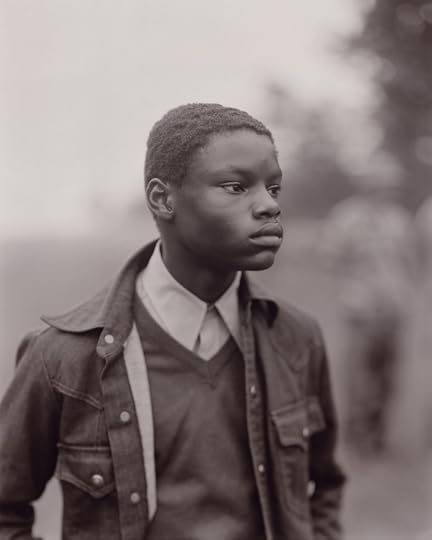 Judith Joy Ross, Untitled, Vietnam Veterans Memorial, Washington, D.C., 1984
Judith Joy Ross, Untitled, Vietnam Veterans Memorial, Washington, D.C., 1984Ross says she is not interested in photographing people anymore. Or, that she does have a new idea about photographing people that she is intent on pursuing, but she doesn’t want to talk about it yet in a public way. She is recovering from eye surgery that she claims made her vision worse. The world has been so uncertain.
Last year, in the days before the U.S. presidential election was called, Ross began to photograph trees. “Maybe it’s sacrilegious to talk about them this way, but I do see them not as people but as individuals,” she says. We get in Ross’s car, stickered Make America Green Again, and she points out favorite elms as we drive to a cemetery in Bethlehem, from which you can glimpse, through a veil of ropy vines, the cemetery that Walker Evans famously depicted in A Graveyard and Steel Mill in Bethlehem, Pennsylvania (1935). “He couldn’t have photographed from here, because everything’s the same tone,” she notes. Ross comes here for walks, not pictures. “The subject of death is so enormous, who can photograph it?”
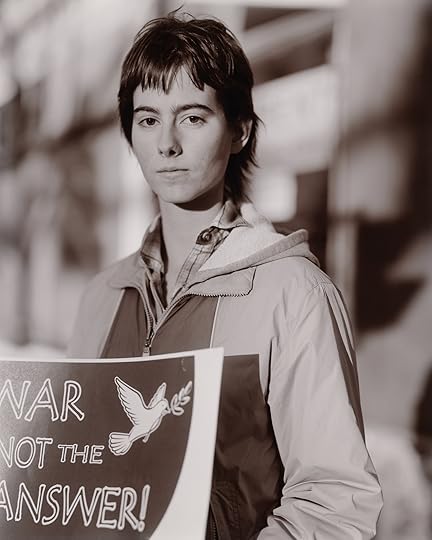 Judith Joy Ross, Annie Hasz, Easton Circle, Easton, Pennsylvania, 2007
Judith Joy Ross, Annie Hasz, Easton Circle, Easton, Pennsylvania, 2007All photographs courtesy the artist and Galerie Thomas Zander, Cologne
She is pleased when I notice that, instead of camera equipment packed in her car, an animal cage rests on the backseat. Later, I will think how cage or trap feels like the wrong word, especially for someone who lights up when she describes seeing a muskrat in the wild and tells me she cannot bear to have dogs anymore (“because you love them more than your family, of course”), especially when I learn that it is for the groundhog that lives under her porch and sometimes ventures to the back steps, standing on its hind legs. She speaks of it in a way, I think, that might apply to some of the people in her pictures: “Sometimes, I think I should try to catch it,” Ross says, “and take it to a happier place.”
In September 2001, Ross began to make portraits at another site of mourning—an overlook on the Eagle Rock Reservation in New Jersey where people come to stare toward New York at the spot where the Twin Towers once stood. Silently, Ross would slip a handwritten request to anyone she wished to photograph. A day after our visit, I drive to Eagle Rock. I try to pick out the people whom Ross might approach, and I am sure I am wrong. On my way out, I notice a young couple walking rapidly away from a marshy thicket, carrying a long trap seemingly identical to the one I’d seen in Ross’s car. The cage is empty; whatever they have brought with them, they have now released.
This article originally appeared in Aperture, issue 244, “Cosmologies,” under the title “The World of Judith Joy Ross.”
September 7, 2021
After 9/11, Do We Prefer Images to Reality?
The only war that matters is the war against the imagination—all other wars are subsumed in it.
—Diane di Prima
In 1999, David Levi Strauss wrote an essay titled “Can You Hear Me?: Re-Imagining Audience Under the Pandaemonium,” in which he ruminates on a crisis of the imagination beset by panic. “A panic is an irrational terror involving noise and confused disturbance,” he writes. “Panic is a disease of the imagination.” According to Strauss, panic was the centerpiece of an “all-consuming Pandaemonium of sound and image”—the ubiquitous onslaught of information in which “the principle requirements of the audience ha[d] become passivity and obedience.” Although this declaration was made before the rise of social media, and only two years before the events of 9/11, Strauss’s prescient declarations seem to have predicted the course of “iconopolitics”—or the use of images in defining political and cultural activity, art, and the imagination—over the last two decades and the rise of American nationalism and global authoritarianism. What was supposed to democratize information instead created a Pandaemonium. The word “Pandaemonium”—borrowed from John Milton’s Paradise Lost meaning “the place of all howling demons”—embodies the irrational. In action it deafens and blinds, confuses and nauseates, pacifies and dispirits us, as on the morning of September 11, 2001, and in the communications environment that followed.
For over forty years, Strauss has written on the effects that photography and images have had on the twenty-first-century imagination. In particular, he has long been concerned with what happens between things—image and belief, words and images, representation and the real—and has contributed to broader cultural discourses on issues surrounding trauma, democracy, audience, human agency, resistance, and aesthetics. Three recent books published in 2020 encapsulate Strauss’s long engagement with these themes. Co-Illusion: Dispatches from the End of Communication (MIT Press), a collection of responses to the 2016 Republican and Democratic National Conventions, which he attended as a “culture spy,” realizes an alarming political crisis that we now know in its full and ongoing monstrosity. Paired with photographs by Susan Meiselas and Peter van Agtmael, Strauss’s dispatches read as an imminent accident occurring in slow motion, each iteration a dream of paralysis as a new kind of iconopolitics unfolds. These themes are critically examined in his exposition “On Images & Magic: Towards an Iconopolitics of Belief,” in The Critique of the Image Is the Defense of the Imagination (Autonomedia), illuminating the importance of magic to our systems of belief and twenty-first-century image use. And his succinct book Photography and Belief (ekphrasis) builds on the legacies of Walter Benjamin, Roland Barthes, Susan Sontag, John Berger, and Vilém Flusser. In it, Strauss delves into the historical, social, and philosophical elements between the two titular terms, while elucidating on the relevance of magic, love, and agency under a perceived reality that incessantly vanishes.
 Susan Meiselas, An amateur photographer on Church Street captures the collapse of Tower 2, the South Tower, of the World Trade Center at 9:55 a.m., New York, September 11, 2001
Susan Meiselas, An amateur photographer on Church Street captures the collapse of Tower 2, the South Tower, of the World Trade Center at 9:55 a.m., New York, September 11, 2001Magnum Photos
Strauss’s disquisition on images, belief, iconopolitics, and magic has been haunted by the events of 9/11. On that morning, he was set to begin the first session of his Advanced History of Photography seminar at New York University, where he was teaching. Instead, he was awoken by his wife and, like millions of others, watched the second plane hit the South Tower. When classes began the following week, he told me recently, “the seminar became a triage operation, to deal with the students’ trauma.” He was taken by how utterly transformed they were by their experiences of that day, later writing that “the sadness in photographs, in their relation to death and remembrance, had never been so palpable to them,” while the political uses of photographic images became of vital concern.
For Strauss, 9/11 was a point of convergence—an event that was felt to be very real and unreal simultaneously. As he writes in the introduction to Words Not Spent Today Buy Smaller Images Tomorrow (Aperture, 2014), the day “shifted the ground of our thinking about images, wiping away years of accumulated theories about their effects and meanings, and causing us once again to acknowledge and confront our irrational and enduring attraction to them.” Most of us had “witnessed” the event through images. As Strauss has suggested, we were the targets; that is, all of us watching from afar—us image-witnesses. The imaging of that moment was the point, and Strauss has sought to show this through his writing. Of the dramatic moment when the second plane struck the South Tower, he writes in his brilliant essay on 9/11, titled “The Highest Degree of Illusion” (2001), that “it was immediately frozen into a still image that could be infinitely reproduced. It was not legible as ‘reality,’ but as representation it was indelible.” Once seen, these images were grafted into the depths of our minds as a permanent fixture easily conjured and suffered all over again. That is the visual impact of 9/11, an event that can be seen to represent the true meaning of the Sublime (the provocation of terror or horror in the audience); the destruction of those two monumental pillars became symbolic of a radical dislocation of the real.
9/11 and its aftermath manifested as a physical, psychological, and temporal wound: a hole in the building, the loss of loved ones, a mark on the social body, a scar in the collective consciousness.
Belief is inherent in our desire for images, and photographs, according to Strauss, have enough unreality in them to make an event such as 9/11 real to us. As he writes in “The Highest Degree of Illusion”: “We cannot bear reality, but we bear images—like stigmata, like children, like fallen comrades. We suffer them. We idealize them. We believe them because we need what we are in them.” The complex relationship we have with them is bound up in empathy, compassion, and our relationship to “the Real”—the physical and temporal world as we know it. 9/11 was a supreme example of this: “The affective unreality of the event cried out for representation,” Strauss writes in Words Not Spent Today. It cried out because our belief in images was in a state of crisis; Postmodernism and related discourses had dismantled photographic “truth,” while the booming digital and electronic environments had made image manipulation more accessible and dissemination faster and farther reaching.
9/11 and its aftermath manifested as a physical, psychological, and temporal wound: a hole in the building, the loss of loved ones, a mark on the social body, a scar in the collective consciousness and unconsciousness alike, the now absent towers in the city skyline, and the final impressions, two wounds in the earth where the towers once stood. It was a visual event that was felt through images. Like Saint Thomas the Apostle, we “had to be shown the wounds, as a therapeutic act, to know the trauma,” Strauss writes in Photography and Belief. However, under the Pandaemonium, the ubiquity of images has not given way to a more democratic image-savvy population but rather has burgeoned to create the opposite. As Strauss writes in the preface of Co-Illusion, “The damage done to the symbolic order—to words and images and their purchase on the Real—will take a long time to repair, and the effects of this assault on the public imaginary will be far-reaching and long-lasting.” Strauss believes more images are needed, not less, and that these are images charged with meaning, such as those made by artists and photographers, and images he terms “non-allopathic.” He differentiates between allopathic and non-allopathic images in his 1994 essay “Take As Needed” from Between Dog & Wolf, explaining that the former are anodyne—meant to treat symptoms and lull us into some state of complacency—while the latter have agency and value in a way that treats the cause of affliction and can be revelatory. As an example of the non-allopathic, Strauss mentions a drawing his four-year-old daughter gave him when he returned home after surgery and a stint in the hospital: “She instructed me to drape it over my injury whenever I could, especially at night,” he writes, and “scolded me whenever I forgot to use the image properly.” As such, this drawing became “a practical talismanic device to aid in healing.”
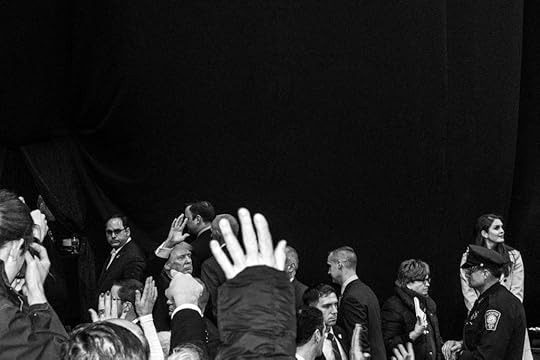 Peter van Agtmael, Donald Trump waves farewell to the crowd at a rally at Verizon Center on the eve of the New Hampshire primary, Manchester, NH, 2016
Peter van Agtmael, Donald Trump waves farewell to the crowd at a rally at Verizon Center on the eve of the New Hampshire primary, Manchester, NH, 2016Magnum Photos
Images are bound up in magic. We exchange them and use them to influence, convince, provoke, soothe, and so on. They are also used on us, and against us. “Fundamental to magic is the law of sympathy, whereby things act on one another at a distance through invisible links,” Strauss writes in his essay in The Critique of the Image is the Defense of the Imagination. “The manipulation of such linkages is known as binding.” For Strauss, magic is the invisible link between image and belief and is crucial in our defense of the imaginary. In his essay, “In Case Something Different Happens in the Future: On Joseph Beuys and 9/11,” Strauss returns to Beuys’s artwork Cosmos und Damian (Cosmos and Damian) from 1974. This work, made during the artist’s first visit to the United States, and specifically New York, is based on a 3D postcard photograph depicting the Twin Towers from an aerial vantage point. The towers have been softened and tinted yellow, “making them look like two sticks of butter or fat” as Strauss puts it. On them, Beuys inscribed the names “Cosmos” and “Damian” in blood-red ink.
For Beuys, Strauss writes, the towers had already symbolized death: “rigid, cold, dedicated to the accumulation of money and world domination under Capital.” The inscriptions reference the twin Arab saints and physicians Cosmas and Damian, who were known for their free services, “cooperation and cross-cultural surgery” but were inevitably martyred by beheading. The two were a favorite subject for painters and, most famously, for being the first to successfully complete a surgical transplant, when they removed an Italian man’s diseased leg and replaced it with a previously-deceased black man’s leg, the graft of a Muslim’s appendage onto a Christian’s body. Cosmas and Damian, in Strauss’s words, “are later manifestations of the ancient Indo-European myth of divine twins, and especially the tradition of twins as magical healers.” As Strauss makes clear, it is impossible now to see this work as anything but “a therapeutic operation” in a post-9/11 world. Through symbolic action—or image magic—Beuys attempts to heal the visible and invisible wounds of the structures by renaming them as these “great healers.”
 Susan Meiselas, Indiana Governor Mike Pence, VP nominee, speaks to the Republican National Convention, Cleveland, 2016
Susan Meiselas, Indiana Governor Mike Pence, VP nominee, speaks to the Republican National Convention, Cleveland, 2016Magnum Photos
Today, this work has multiplied in its effect, and Strauss pointedly revives it among us. The many emotions post 9/11 were seized and capitalized on by those in power, who ultimately drove the US into pointless conflicts marked by war crimes and torture, and enacted draconian legislation that weakened our democratic institutions and enabled widespread spying. Many images were weaponized to this end, while others were censored and hidden. Today we witness the consequences, with the Taliban reclaiming Afghanistan and the failures of the United States on full display, again through images. Beuys’s work, through Strauss’s eyes, becomes a funerary image—not just of 9/11 but of the polarizing aftereffects (the afterimages) that have led us to this moment—that is also non-allopathic: it cries out for cross-cultural compassion and deep healing.
It’s not that we “mistake photographs for reality,” according to Strauss, but that “we prefer them to reality.” They do things for us as much as they do work on us. In Between the Eyes: Essays on Photography and Politics (Aperture, 2003), he describes that in the nightmarish scene “before the dust from the towers had settled, talismans of loss—photographs of the missing—began to appear, carried through the streets by stunned survivors who rushed to try to forestall their loss of the originals. . . . Within days the talismans were transformed into funerary images, but still the living clung to them like life preservers that buoyed them over despair.” The “image-bearers” among the toxic dust and death, with their talismans in hand, became incredibly potent sympathetic images themselves. They provoked in us all a deeply felt humanity, eradicating divisions in the name of our human bond; they showed us how, Strauss writes in Between Dog & Wolf, “non-allopathic approaches recognize that images and symbols are real, and that the crystallization of a desire or concept in the form of an image can become a potent agent, directly effecting the course of events.”
The physical and visual wounds that were created on 9/11 have been repeatedly attended to through image and text by many cultural surgeons, Strauss among them. For him, writing about these difficult subjects is itself a magical act, one which, like his daughter’s drawing or Beuys’s remedy, is meant to have agency that spurs one into action. Therefore, his writings must be applied like a woven suture into the social body of humanity. And we must read them in as an ecology of the divine twins: image and belief. That is, if we are to defend the imagination, which has been under attack since that catastrophic, fiery morning twenty years ago.
A Photographer’s Heartbreaking Images of the 9/11 “Missing” Posters
The day after, the streets were empty. From 14th Street down, east and west, the police patrolled. If you lived below 14th Street, you needed to show proof of your address to be allowed home. Few people walked the streets, fear permeated ordinary habits, and no ambulances screamed up the avenues from the pit, though some sped down, and there were fire trucks. For a while, fires smoldered on the ground, burning the soles of rescuers’ shoes and the paws of search-and-rescue dogs. The fumes were poisonous and deadly, though New Jersey’s governor, Christine Todd Whitman, told us it was safe. She left office that same year.
Wounded people, survivors, were expected and awaited. But there were hardly any the first day, then fewer the next. Families and friends hoped and waited, and grew desperate. Time passed, precious days. People hoped there might be a miracle—my child, my spouse, brother, sister would be pulled from under the ruins. They waited, while hope evanesced. Soon, terror and grief overwhelmed every one of them.
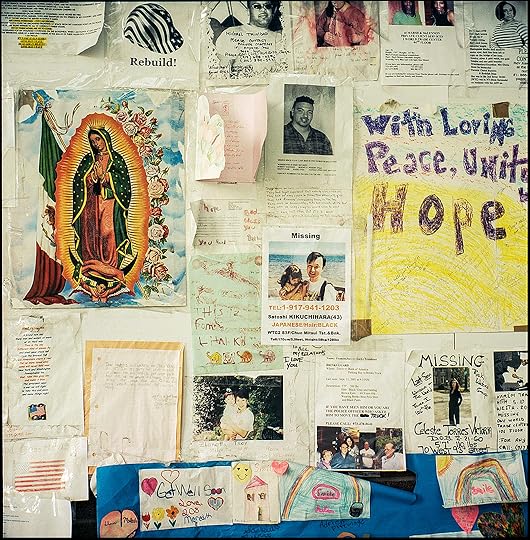
A profusion of 8-by-10-inch posters, hundreds of them, thousands of images, appeared around the city, taped to chain-link fences, stapled and tacked onto community bulletin boards, on school and church walls; Trinity Church, near the site of the disaster, and Grace Church were festooned. The posters hung on fences and were propped on tables. They were typed, handwritten and -drawn, drawn with crayons or ballpoints, some on board, most on paper, with a name and picture, sometimes a more elaborate description, or just a scribbled sentence: “Please, have you seen. . .”
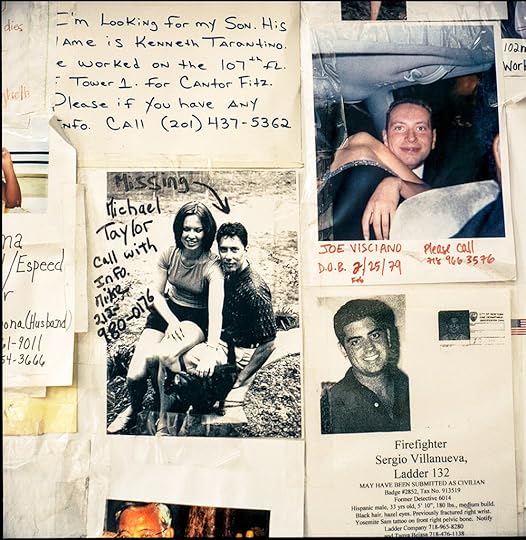

Steve Pyke didn’t print the photographs he took of the 9/11 posters then. “I didn’t even look at the work at all until recently,” he said, and this is their first publication. The 9/11 posters confirmed a gruesome reality: 2,763 individual deaths in the towers, including 343 firefighters and paramedics, twenty-three New York City police officers, and thirty-seven Port Authority police officers. The posters told us these were not anonymous victims. Each person was wanted.
Plain and startling, a plea written by hand with a black marker on a concrete wall, “PLEASE GIVE ME BACK MY SON,” appeals to God or a higher power. The wish registers a pain impossible to describe, retaining its anguished relevance, since every single day wars and illness take sons and daughters.
The photograph of “MISSING FROM TOWER 1 / 97th FLOOR / Please Help Searc. . . / Thank You!” displays this and other posters, row under row, respectfully. All sit neatly side by side, an accumulation of faces, some big images, some small, in color or black and white. “MISSING” at the top of some. Or the name of the person. Each description is carefully wrought to bring them to life, to encourage the search for them. “Wearing docker pants—grey pullover.”
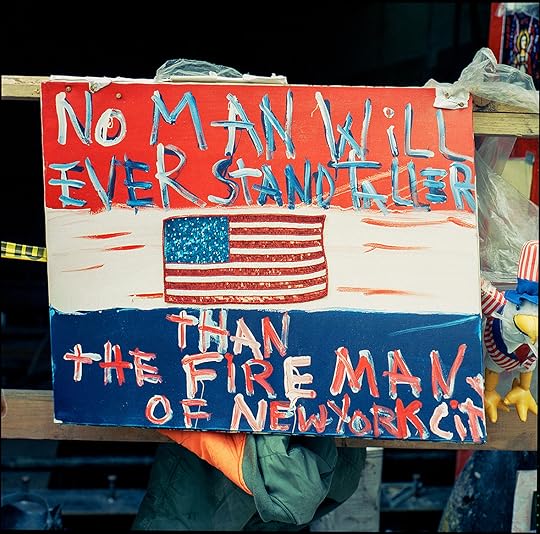

On one poster, a single firefighter wears his uniform and cap; it appears to be an official portrait. On the day, firefighters raced to the site and ran up staircases, like scaling a mountain, going up while people ran down, trying to escape. The firefighters kept going up, which their job required, but their eventual sacrifice of life stunned New Yorkers. Many of the posters honored them, schoolchildren thanked them. Later, downtown firehouses—their firefighters were the first to arrive—hung permanent plaques honoring their dead colleagues.
There are differences among the posters—the people’s faces, design, contents—but the same fate overwhelms any differences. Looking at them back then, I had to turn away, they were heartbreaking. Many people had been photographed smiling—of course, we often smile for photographs—so the juxtaposition of a happy past with a future to a terrible present was immensely disturbing.
Hope was lost, and the posters yellowed and faded; weathered, they looked ragged like grieving faces. They transformed into tributes, not “have you seen my. . . .” but entreaties to remember them.
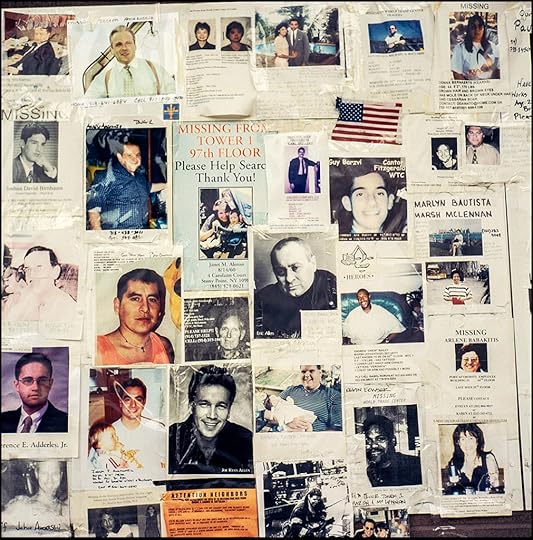
Pyke didn’t publish his photographs then, because “it was such an awful time, and was followed so quickly by knee-jerk reactions, not just in government but across the land. I guess I couldn’t face them.” One of these “knee-jerk reactions” was to memorialize, instantly. The clamor was loud. For almost ten years, fierce arguments about an eventual memorial shadowed the tragedy. These posters should have been the memorial, I thought then and now. And the beam of light, like a tower, emanating from the site every 9/11—it could have memorialized them with its impermanence.
Twenty years later, the posters are still hard to face. Time is its own demiurge, and events since—historic shifts, environmental shocks, new movements—affect seeing them now. After 9/11, there came more disasters, specifically the US’s preemptive war against Iraq. That huge, human-made destruction continues unsettling countries, claiming lives, and treasure.
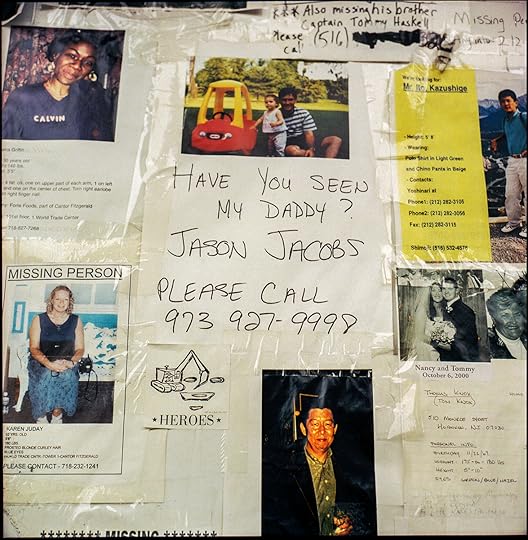
Steve Pyke, Missing, September–November, 2001
Courtesy the artist

All disasters have their own faces, though death is faceless, and loss is loss everywhere. Still, the posters’ impact survives the event. They locate a moment in time that seems to have changed everything. And, on this twentieth anniversary, with the Taliban recapturing Afghanistan, history repeats itself, with differences, or erases itself, but the irony is killing.
Aperture's Blog
- Aperture's profile
- 21 followers



